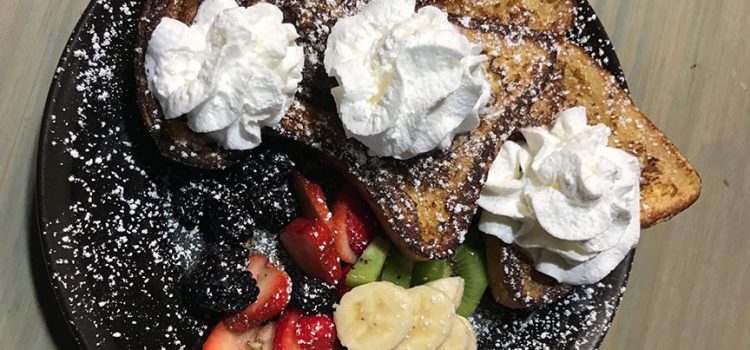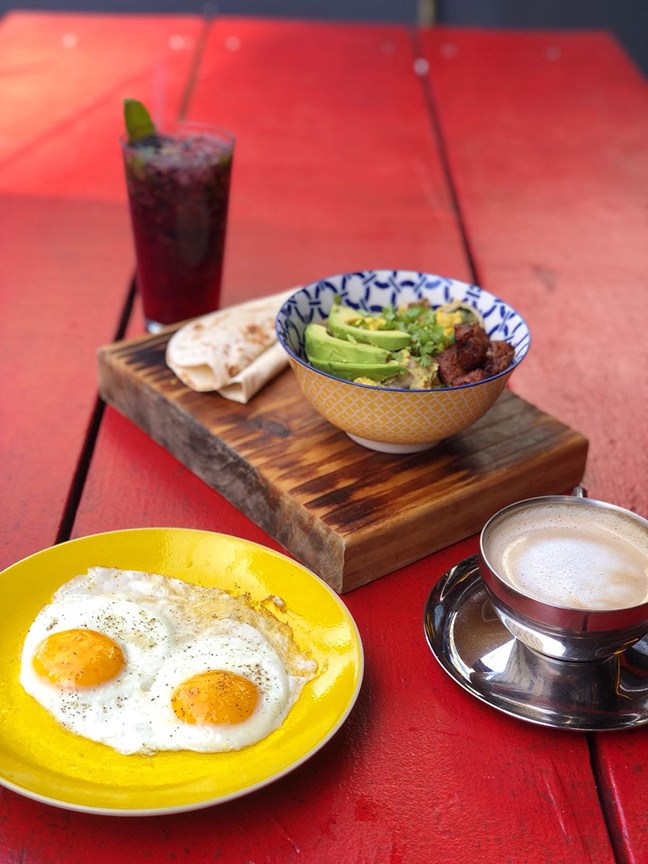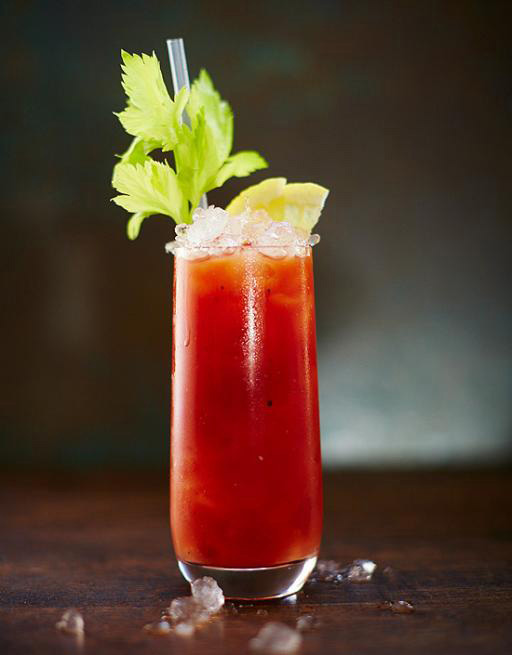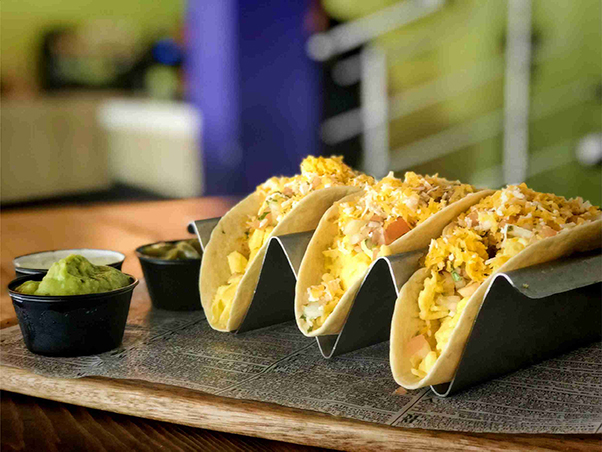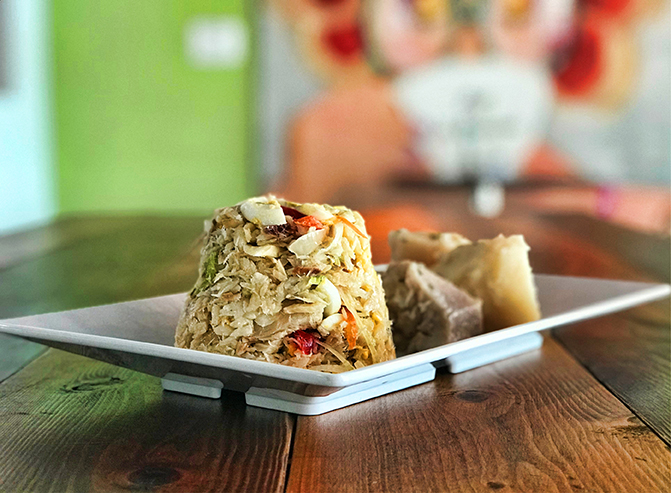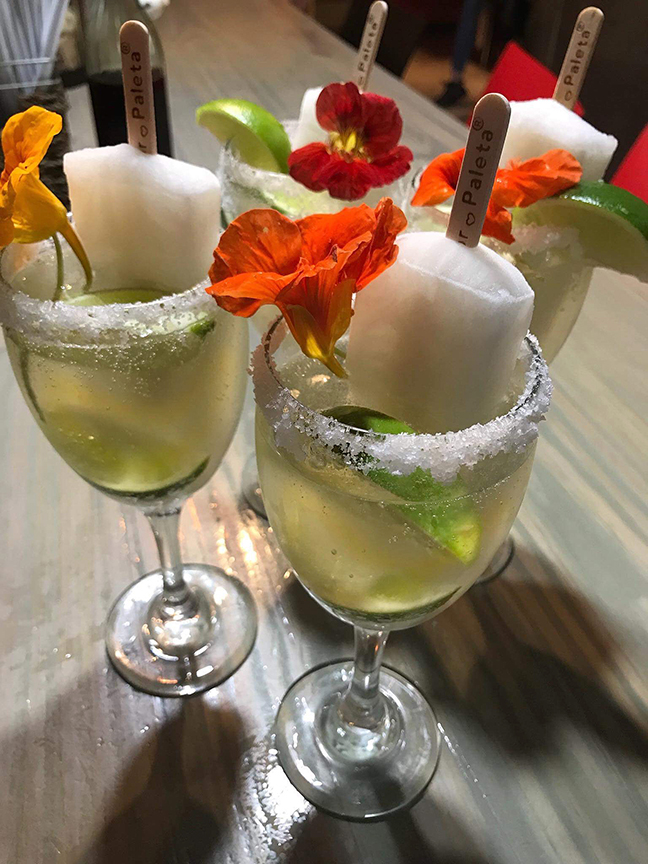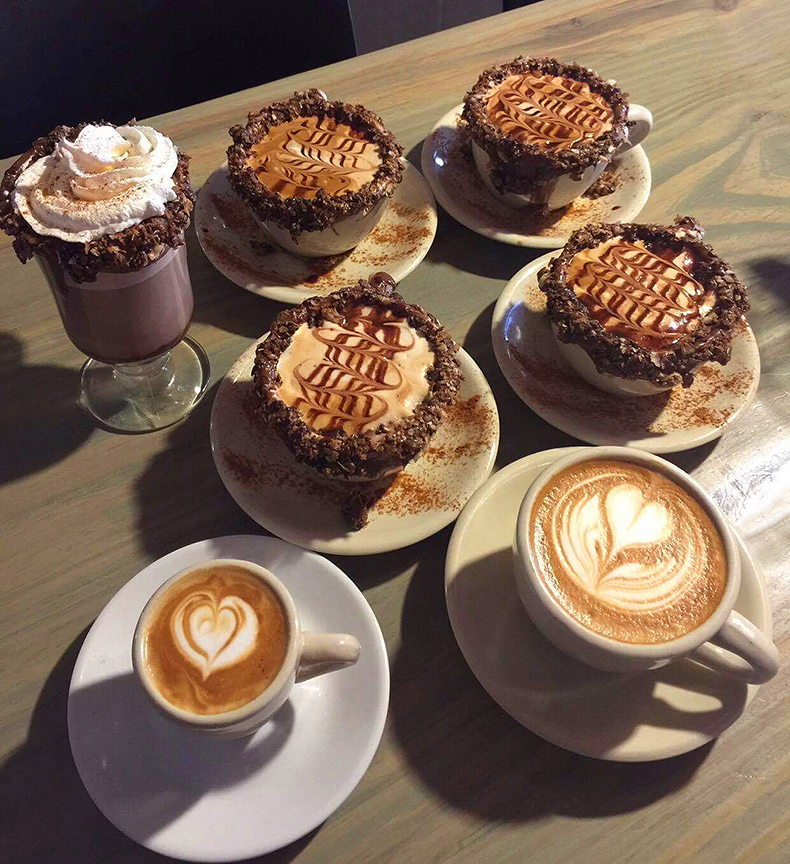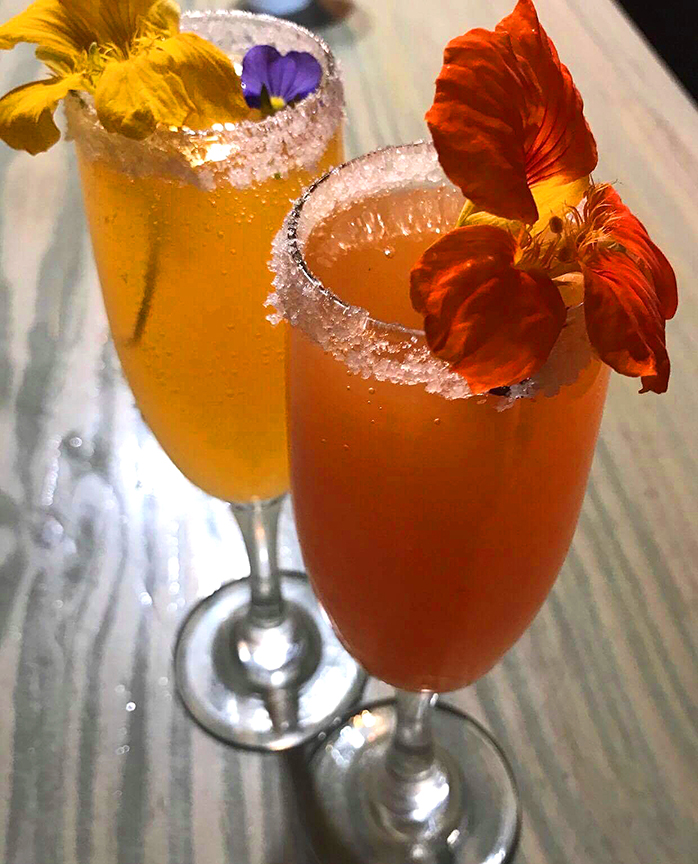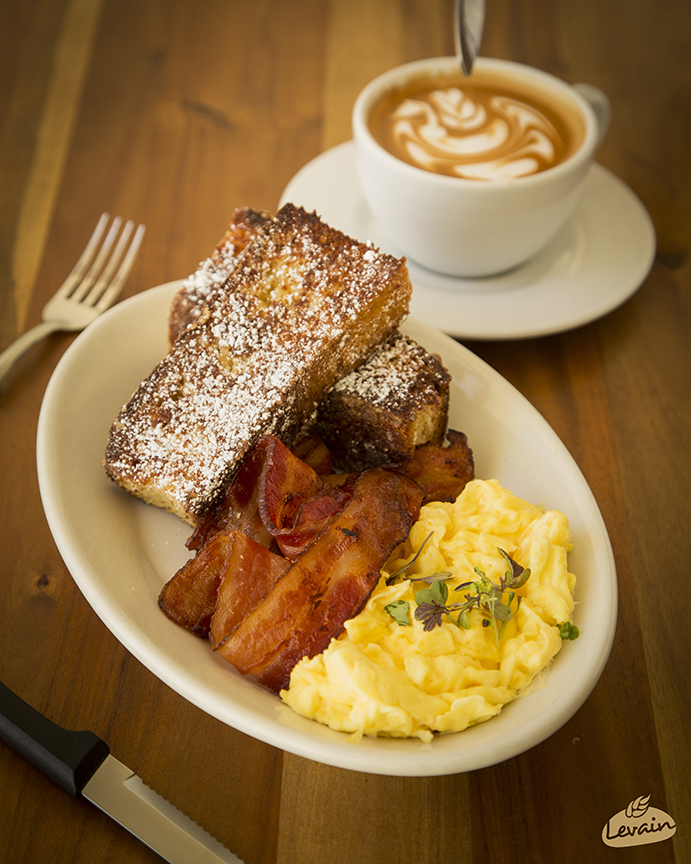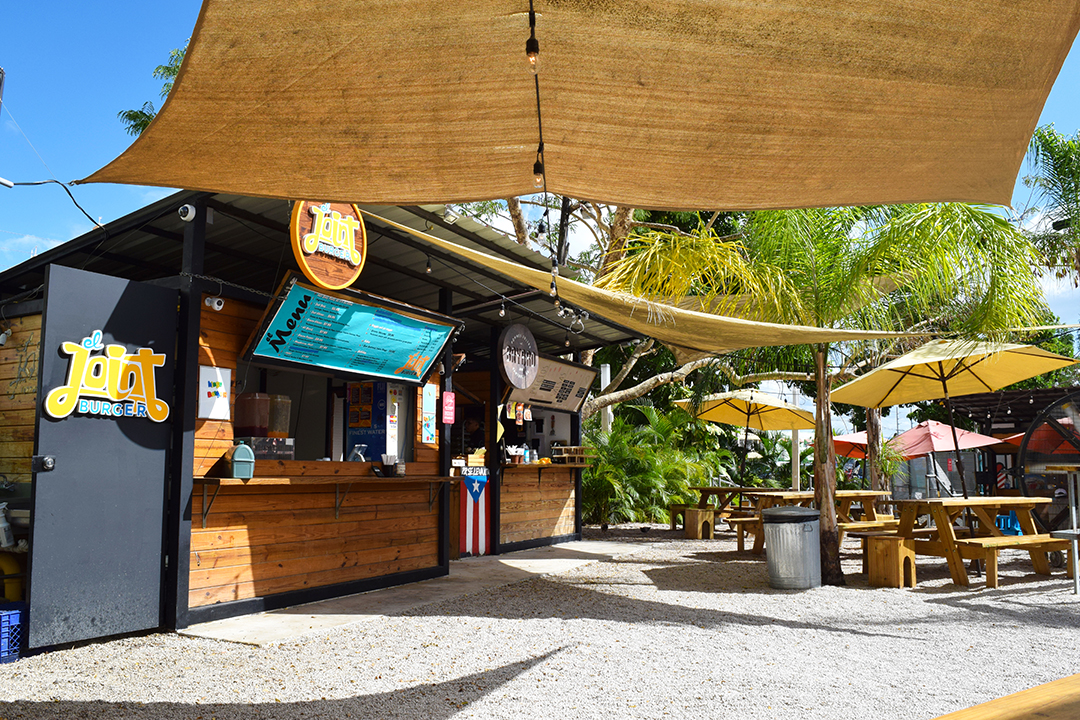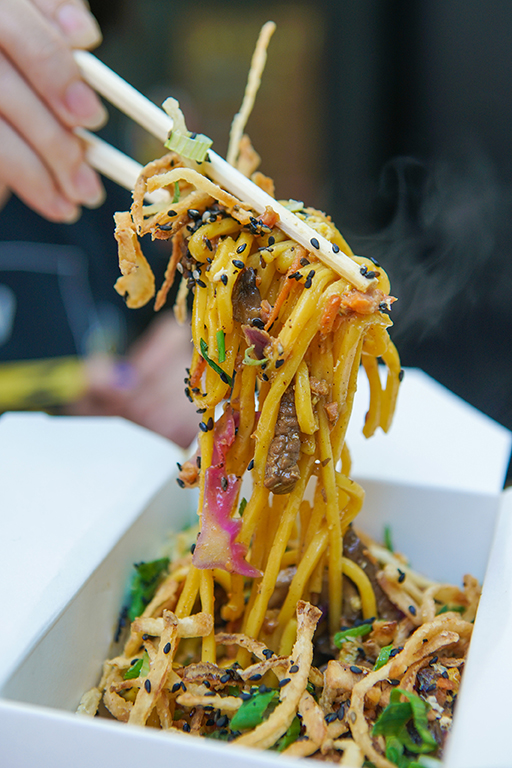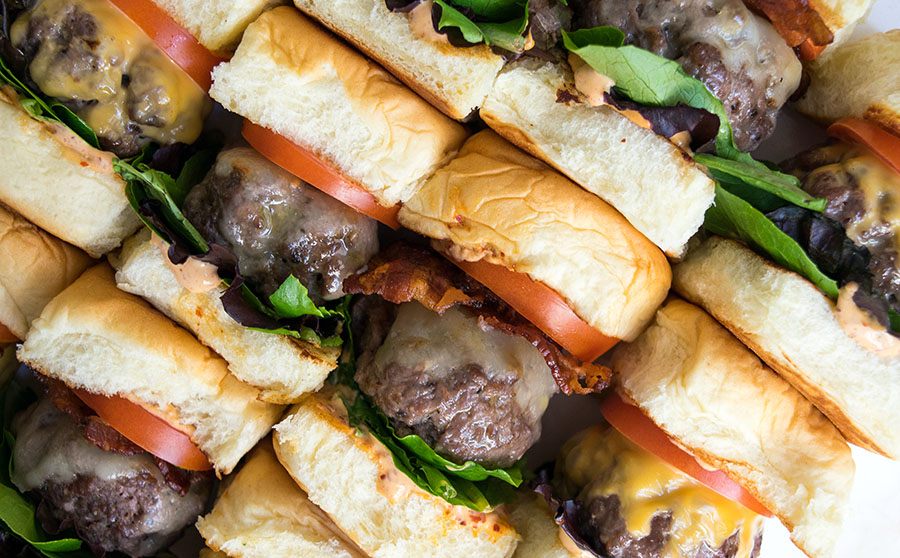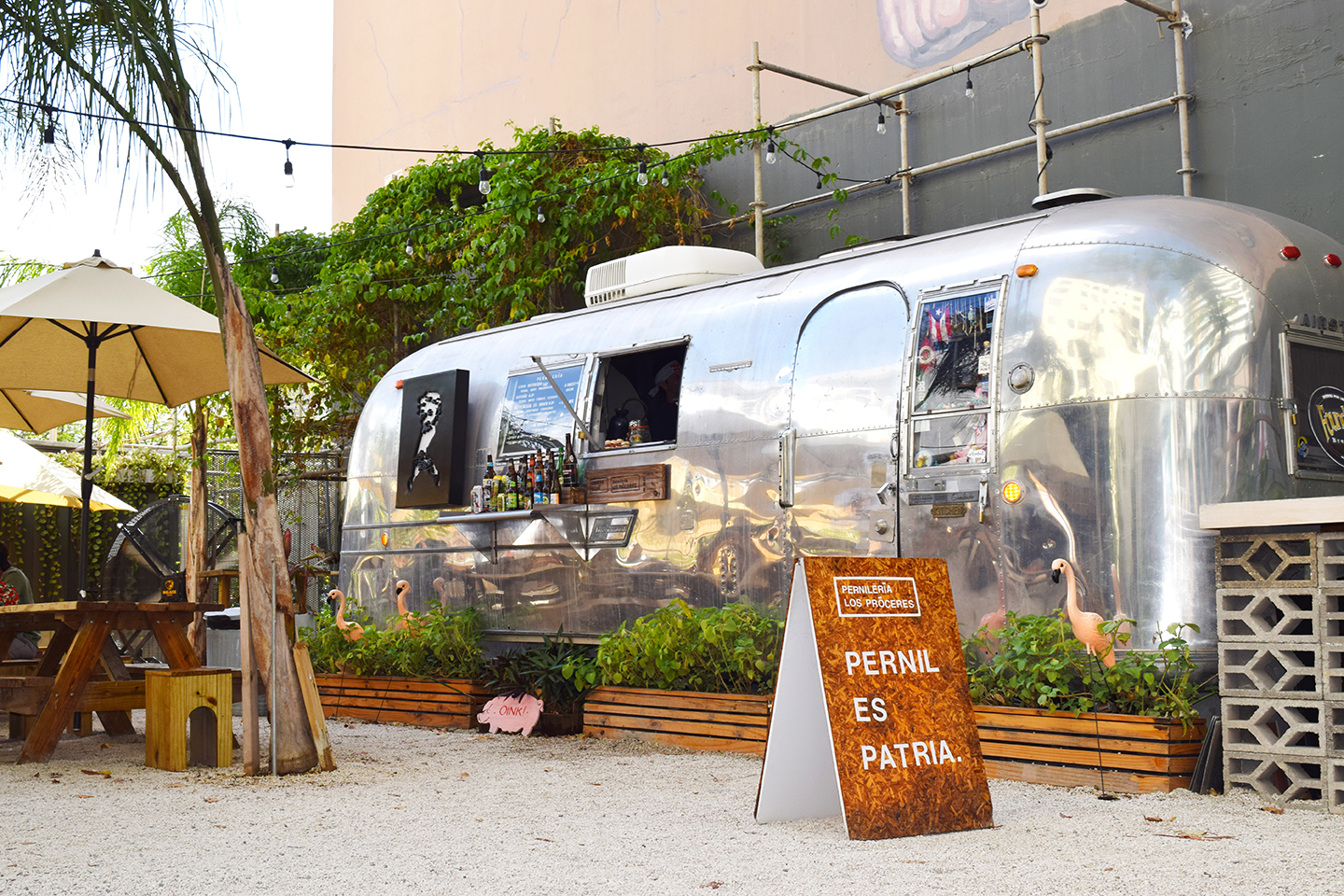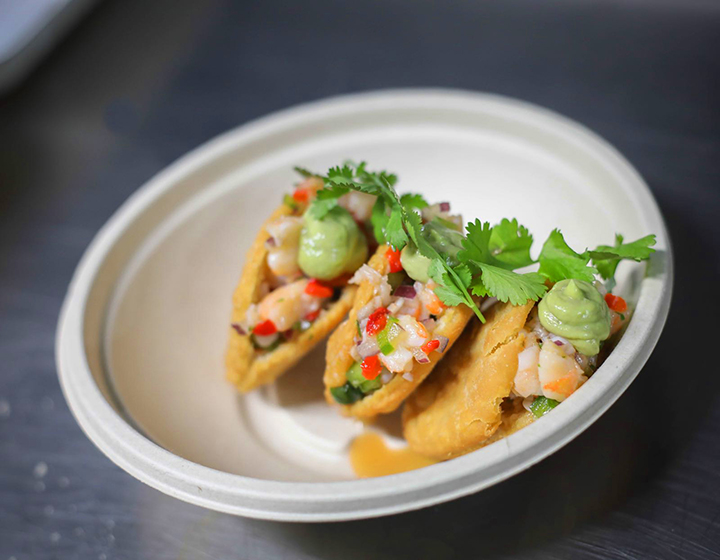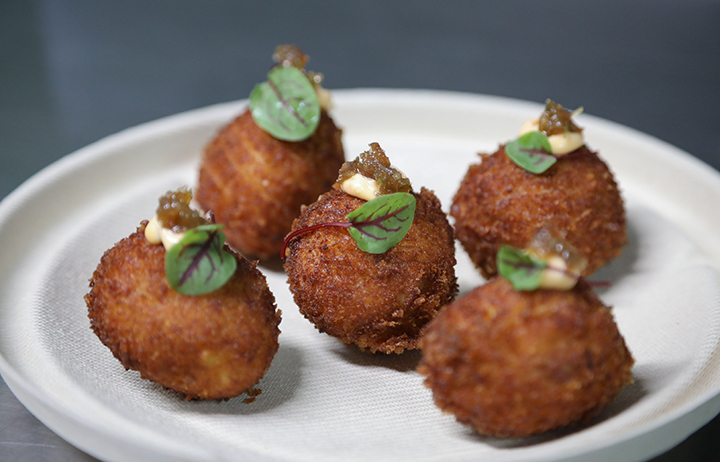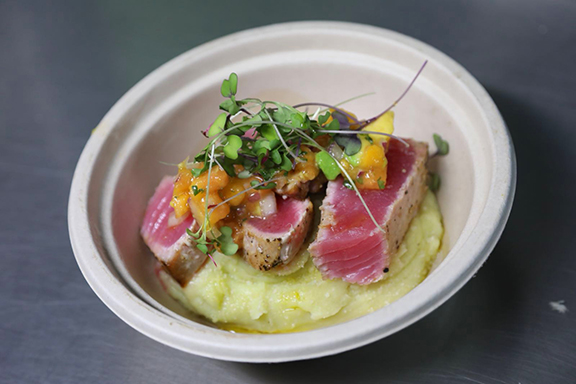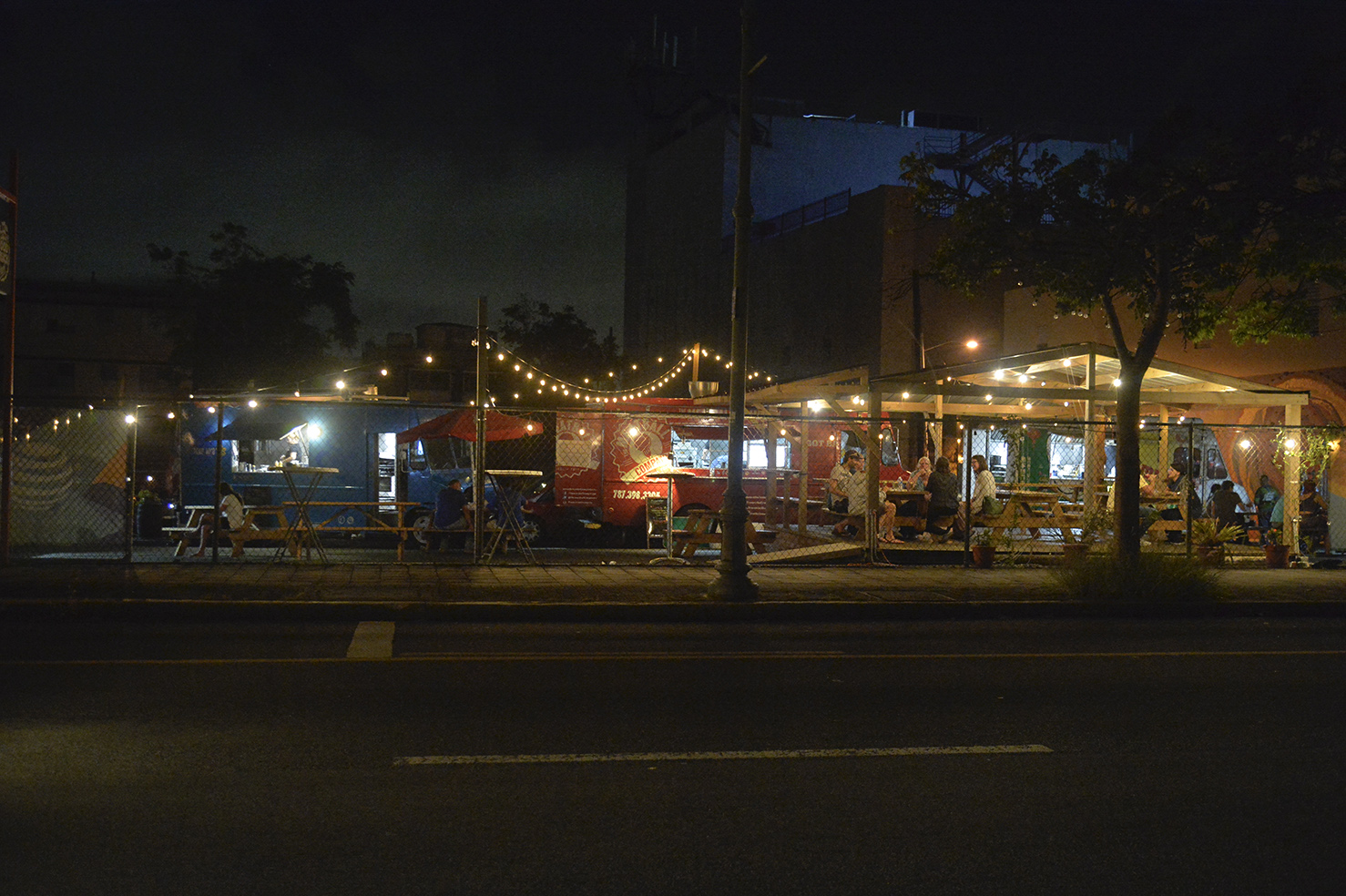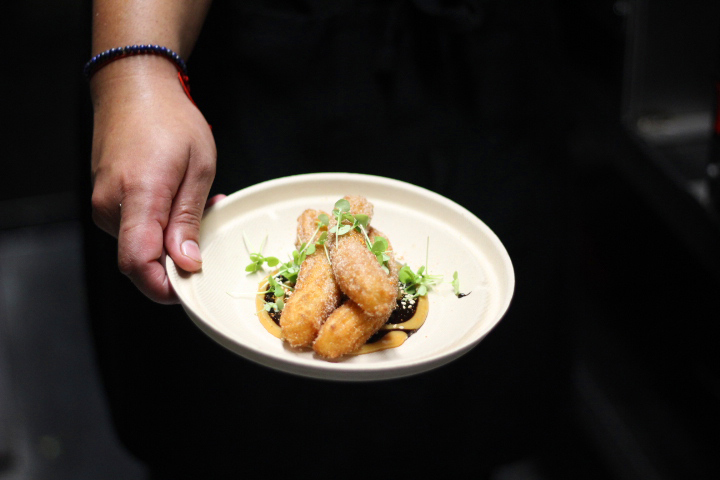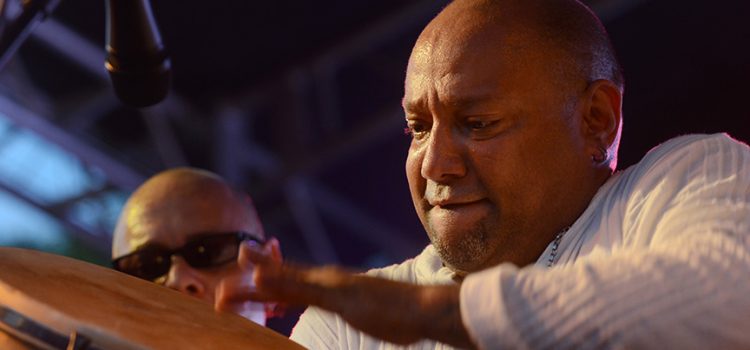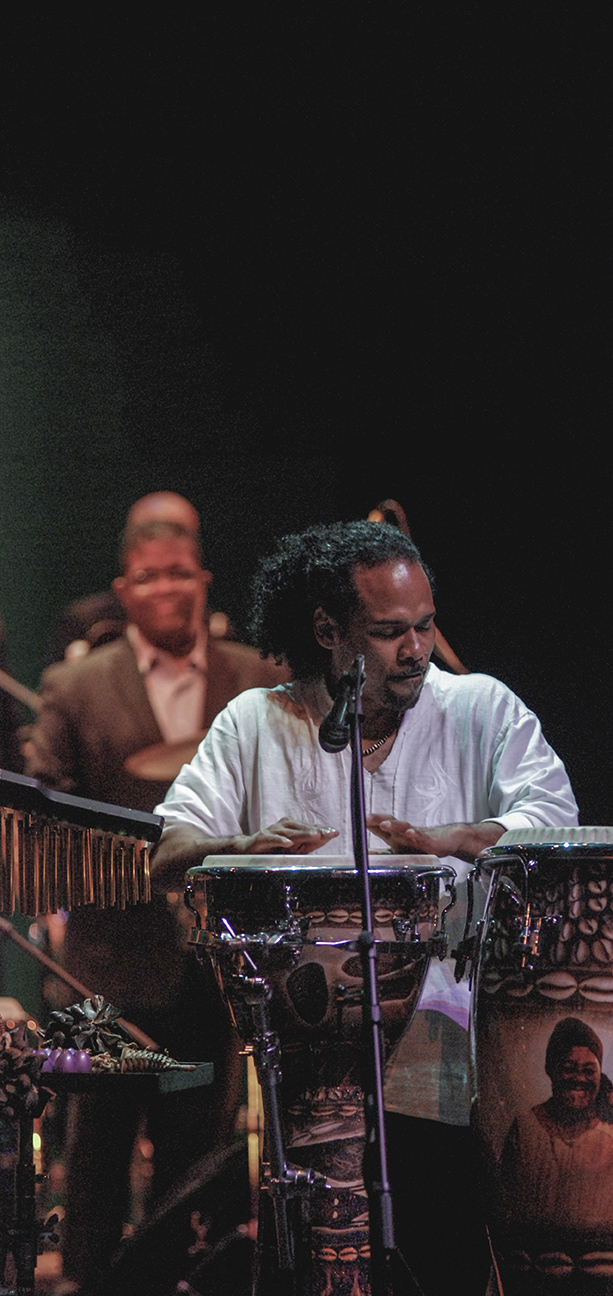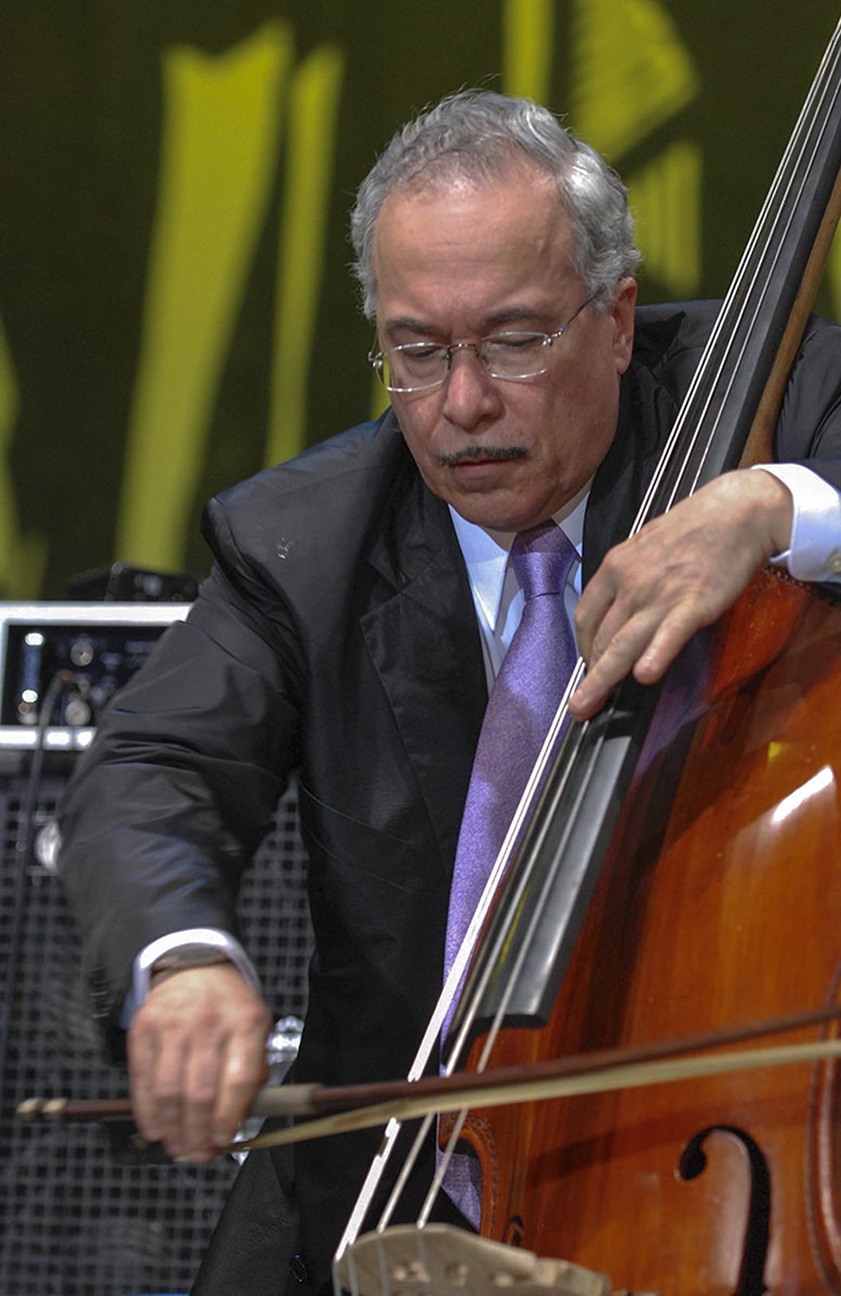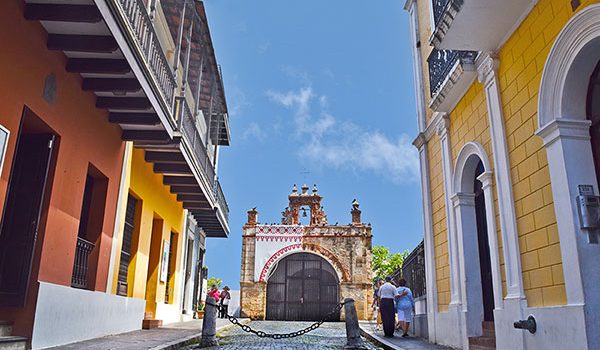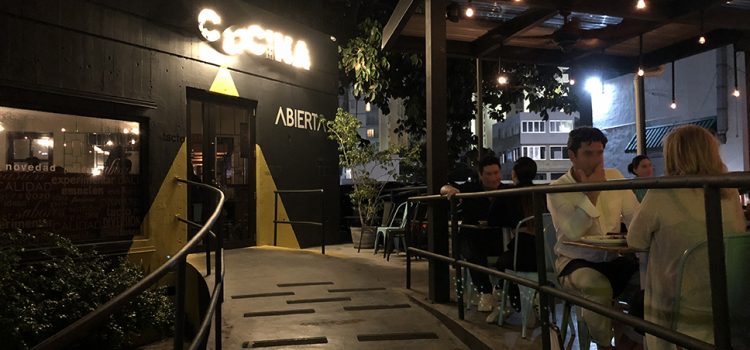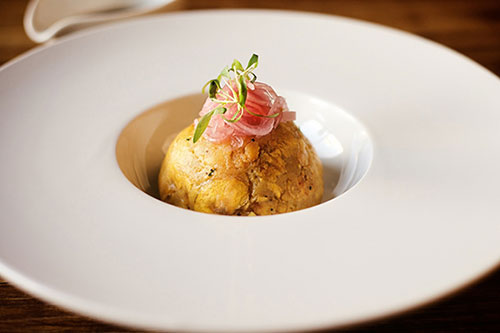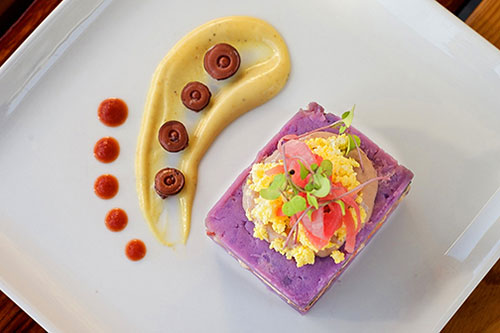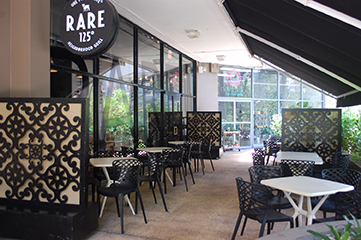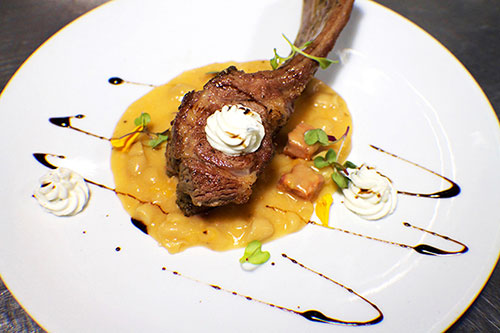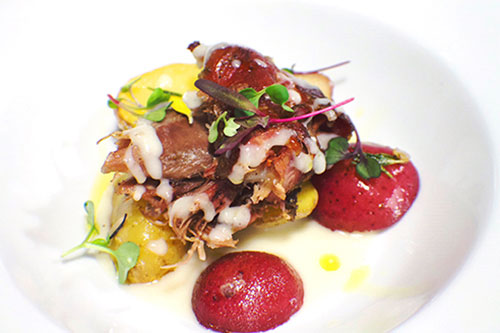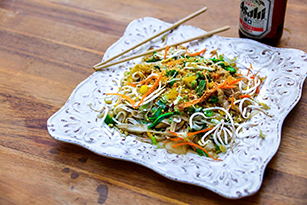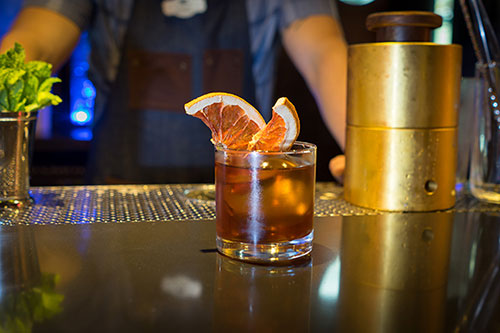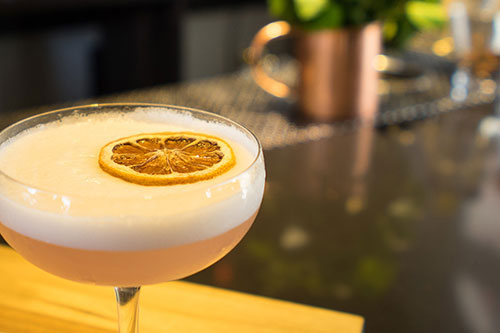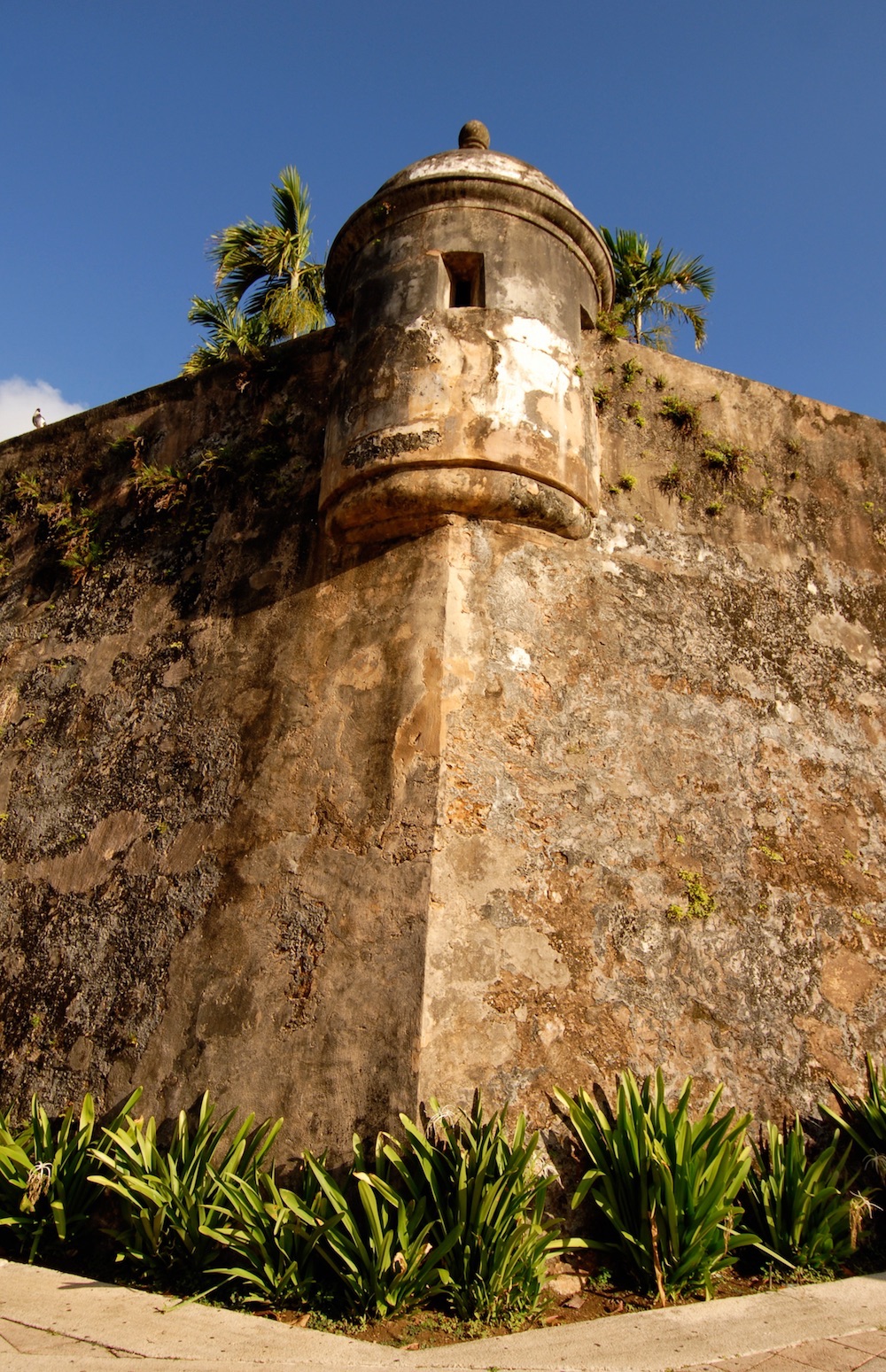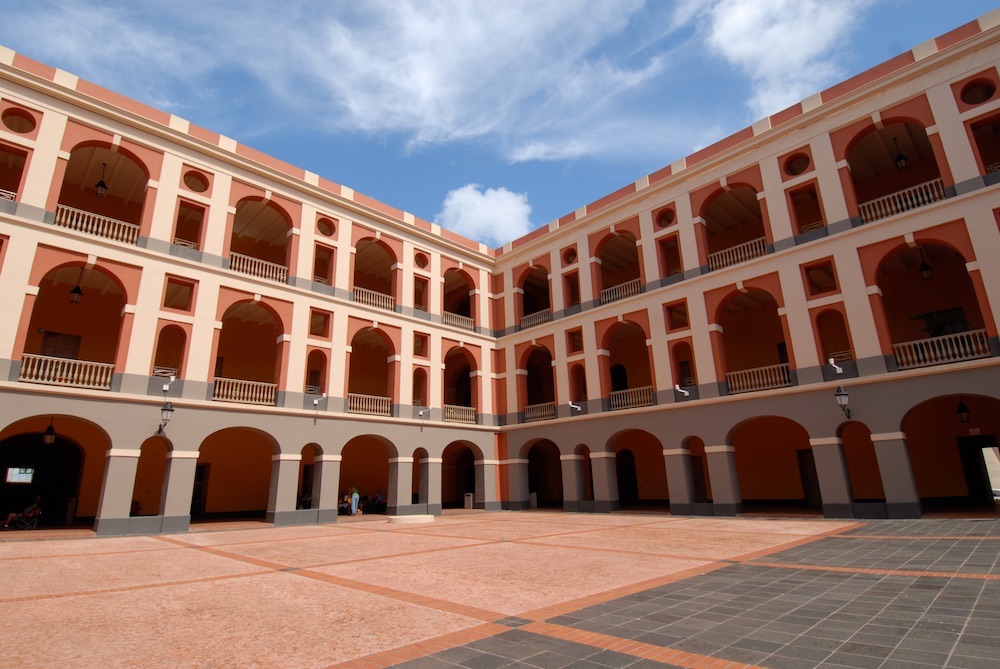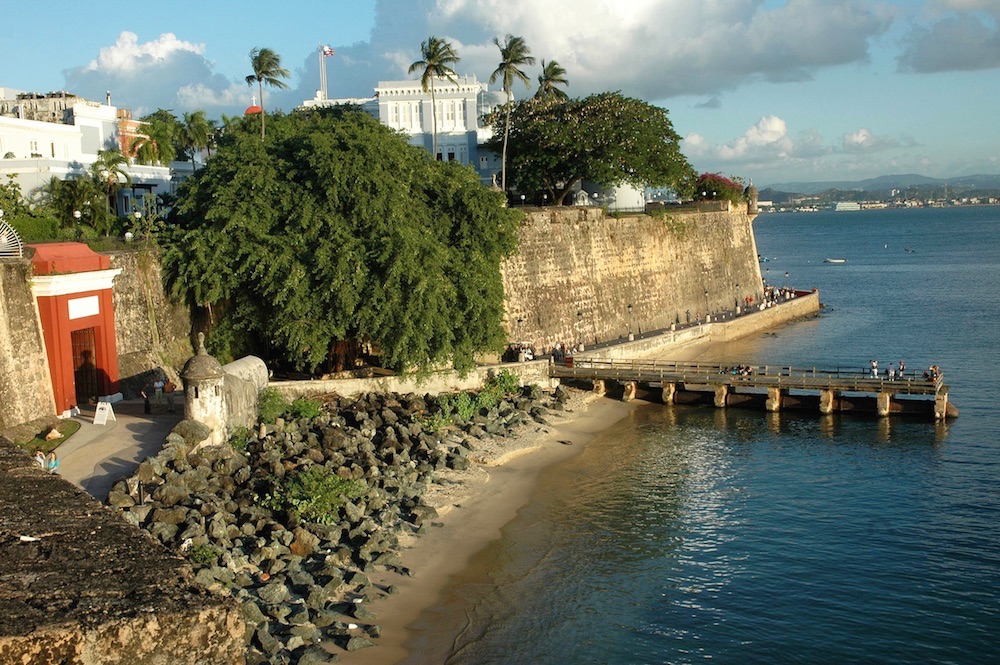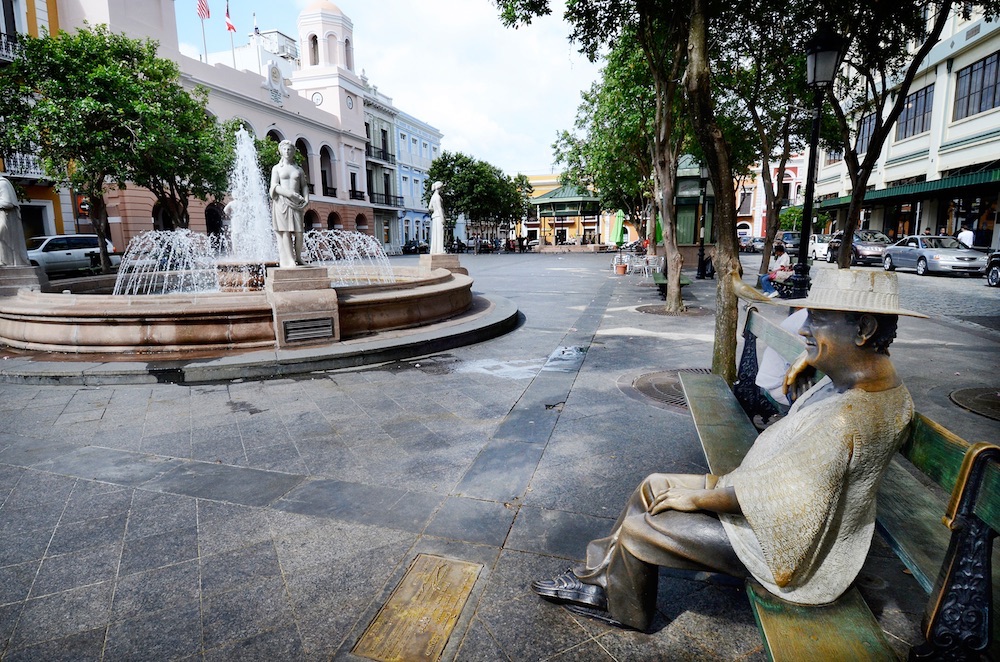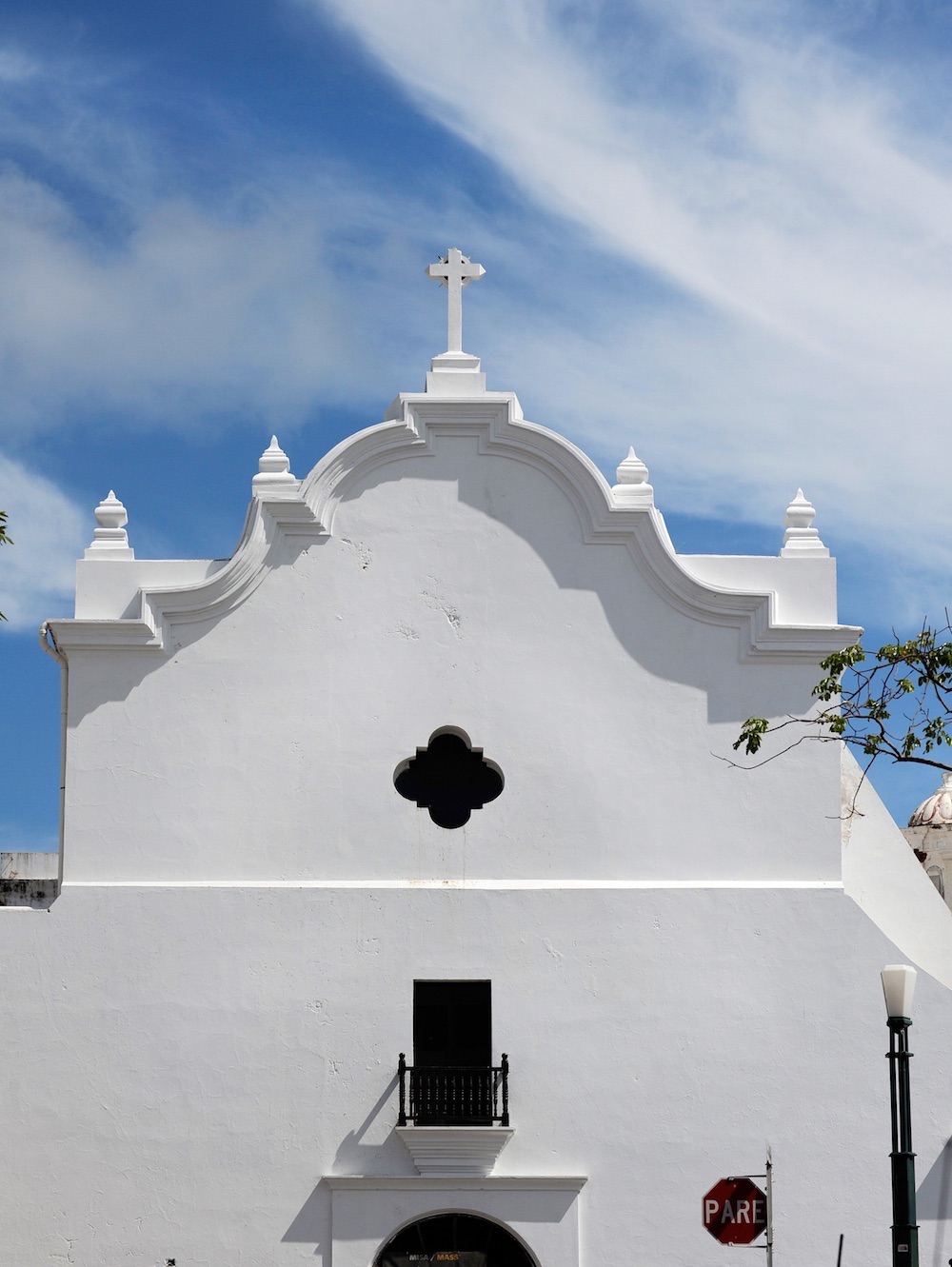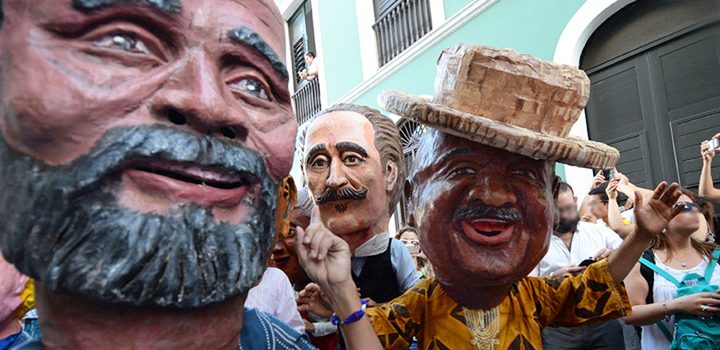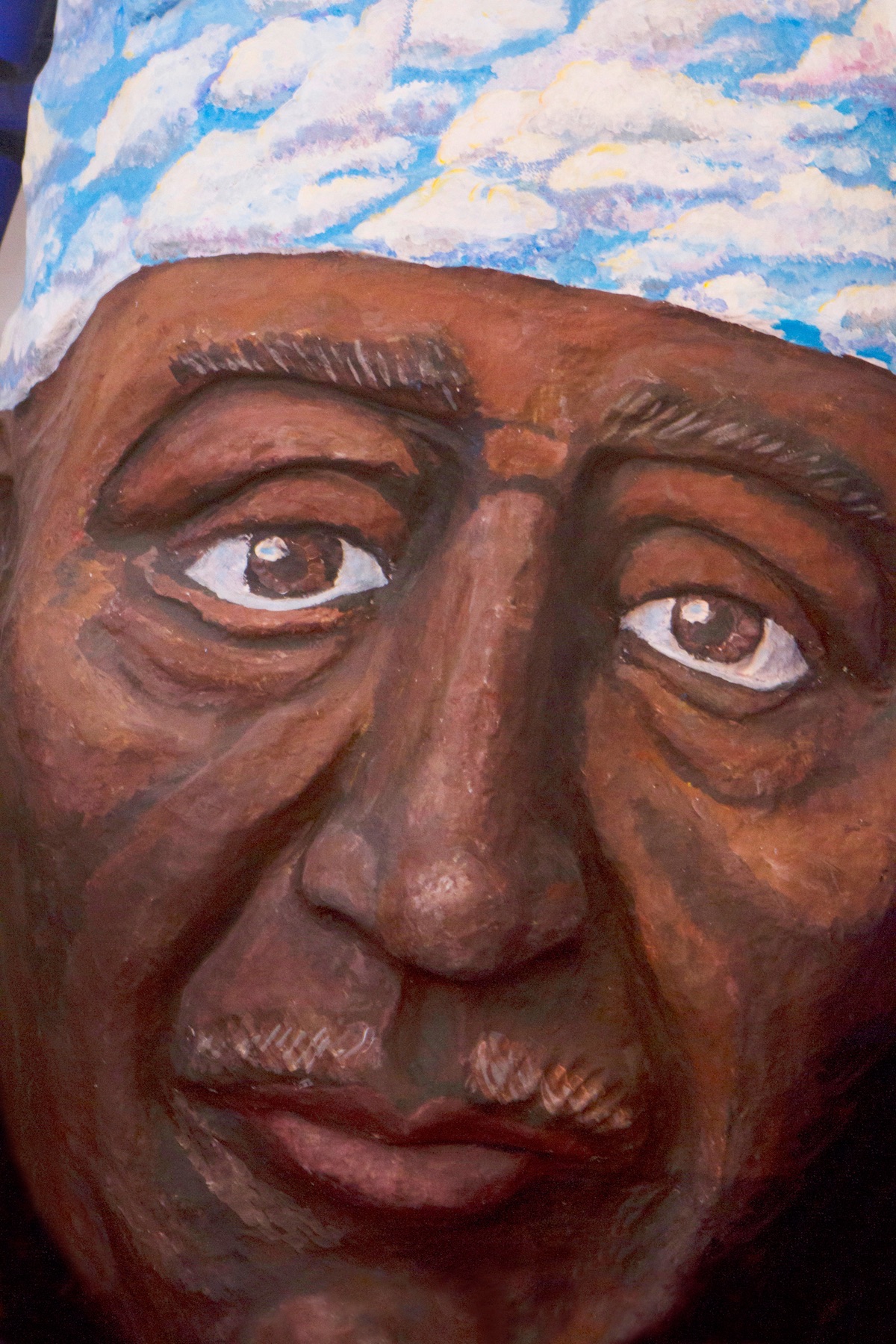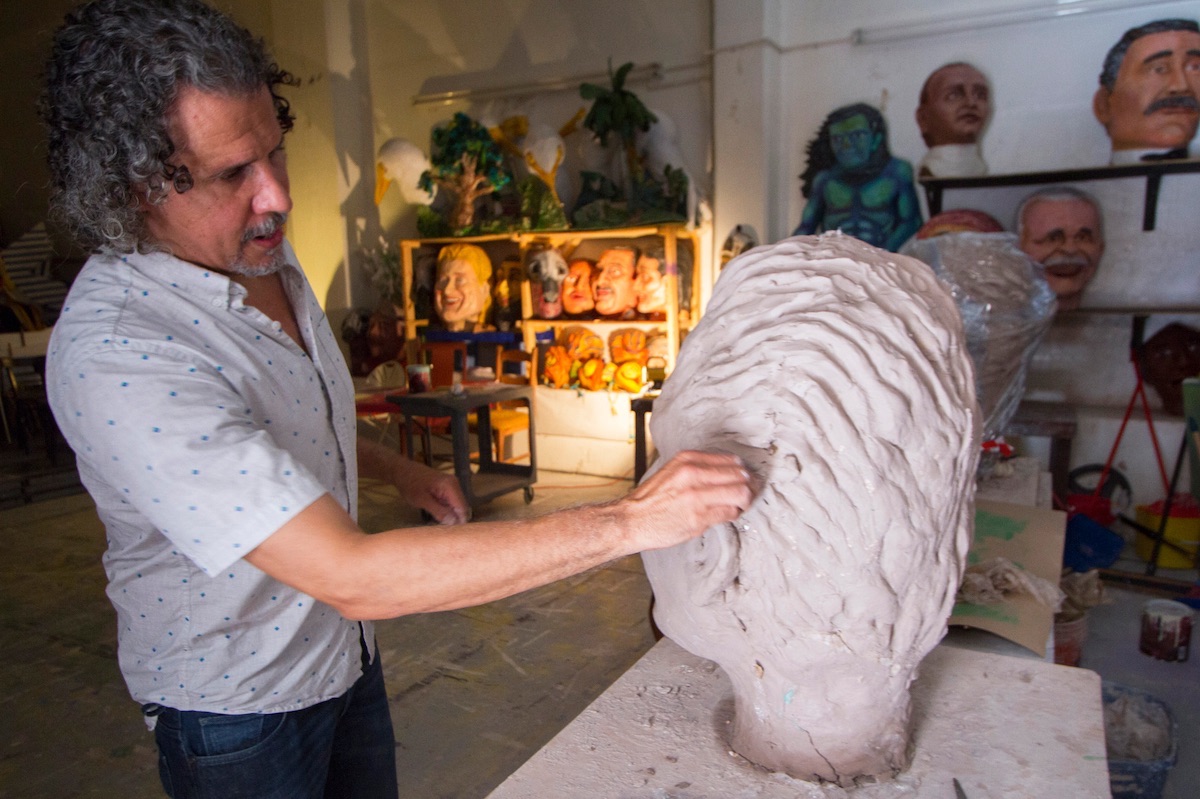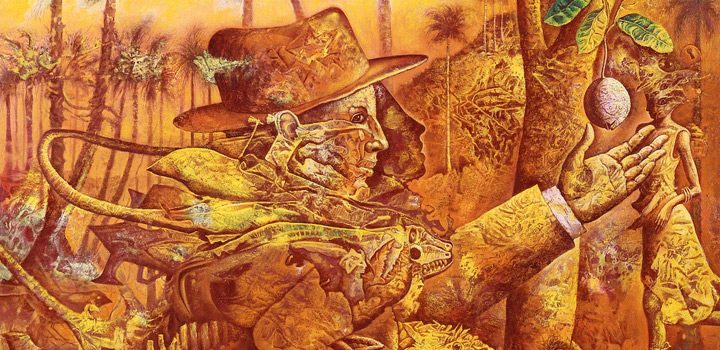Weekends were made for brunching
Weekends are for brunching — chatting with friends, digging into a delicious stack of syrup-drizzled pancakes, lingering over a café con leche, zesty Bloody Mary or a fruity mimosa. Fortunately, Puerto Rico knows how to brunch, and there are a plethora of chic and cozy restaurants where the food is both delicious and highly Instagrammable.
Weekends are for brunching — chatting with friends, digging into a delicious stack of syrup-drizzled pancakes, lingering over a café con leche, zesty Bloody Mary or a fruity mimosa. Fortunately, Puerto Rico knows how to brunch, and there are a plethora of chic and cozy restaurants where the food is both delicious and highly Instagrammable.
Soda Estudio de Cocina is a charismatic and unique restaurant tucked away in Cuevillas St. in Miramar, just a few blocks from the Fine Arts Cinema Café. Its eclectic decor, laid-back atmosphere, unique charm, and great food touted as urban creole make it a perfect place to enjoy brunch and connect with friends.
Some of the best menu items include steak and eggs with a side of truffle fries; pastrami, Serrano ham, and mozzarella cheese; the egg breakfast pizza; asparagus-wrapped bacon with eggs and hollandaise sauce; the mac & bacon cheese omelet; or whatever your little heart hungry heart desires.
Combine these delicacies with Soda’s delicious mimosa mojito or watermelon Moscow mule to spice up your dining experience. Brunch hours are every weekend from 10:30 a.m. to 3 p.m.
Looking for a seriously good brunch spot? Look no further and visit Choices Restaurant at the Sheraton Puerto Rico Hotel & Casino in the Convention Center district. It’s sophisticated yet casual with live music and traditional brunch choices with a creative twist.
Try the crab cake Benedict, or the Brunch Burger prepared with sweet Mallorca bread rolls, bacon, cheese, topped with crispy onions and eggs, or the fantastic Guava pancakes, or the Boricua Omelet with pork, local white cheese, and tomato avocado salad topping. All are absolutely yummy! And all dishes come with a complimentary Mimosa. The brunch menu is available every Saturday and Sunday from 11 a.m. to 2 p.m.
Over in the Condado, widely known as a chic tourist area with fabulous beaches, shops, and hotels in the heart of San Juan, there is a slice of brunch heaven called Blonda for those with pure food indulgence in mind.
This cozy and modern restaurant serves lobster frittata; doughnut sliders; chicken and waffles; pancakes with bananas, strawberries, blueberries and whipped cream or Nutella; ranchero eggs; salmon Eggs Benedict; and an incredible French toast prepared with thick-sliced bread topped with caramel sauce, strawberries, and vanilla or Nutella. Brunch hour is from 8 a.m. to 3 p.m.
With the Atlantic Ocean as the backdrop, Ola Oceanfront Bistro at the sophisticated Condado Vanderbilt Hotel provides the exquisite and unique flavors of Puerto Rican fare.
Its Sunday buffet brunch with live entertainment is out of this world with dishes prepared with the freshest products.
Enjoy fluffy pancakes, frittatas, chicken escabeche or Paella del Campo made with chorizo, pork, ham, chickpeas and plantains accompanied by artisanal bread, fresh fruit, assorted fresh pastries, or bacon.
Combine these classic brunch favorites with bottomless mimosas or signature cocktails like the spicy Bloody Mary, Mai Tai, Old Fashioned, Perfect Martini or Dark and Stormy – made with dark rum, ginger beer, and lime. Sunday brunch is from 11:30 a.m. to 4 p.m.
And you can never go wrong with the Boozy Brunch Party at Serafina San Juan every Saturday from 1 p.m. to 5 p.m. Enjoy breakfast and lunch dishes like delicious orange-cinnamon brioche French toast, lemon ricotta pancakes, smoked salmon benedict and steak and fabulous eggs accompanied by a lively stream of Bloody Mary’s, mimosa’s and more.
Bring your friends and make an afternoon at Serafina as your new weekend kick-off tradition.
Looking for something different for brunch that is available all day, than Pannes in Condado may be a perfect option. When visiting ask for the “French Mess,” made with three fried eggs, bacon, melted cheese served between two French toasts with cream cheese. Mmmm what a delicious mess! Or try the Brunch Burger where a beef patty is topped off with bacon, onions and an egg or the famous Ashford Special Royal, which consists of French toast with Nutella and fresh fruit.
Fresh squeezed fruit nectar and Prosecco make for one refreshing brunch Bellini. But why not pair your morning feast with a glass of Sicily. It’s made with lime juice, simple syrup, Luxardo Maraschino Liquor, angostura bitters, and vodka. Or try the Julius Caesar cocktail with Cynar, Fernet Branca, red grapefruit, and vodka – all perfect concoctions to sip on while eating at Nonna Cucina Rustica.
This inviting restaurant located on San Jorge St. in Santurce has a similar vibe to Italian bistros found in NYC mostly due to its exquisite five-star cuisine.
Whether you’re looking for delicious steak and fried eggs; frittata with mushrooms; Eggs Benedict with red potatoes as a side; or flavorsome French toast made with homemade brioche bread overflowing with almonds and fruit than Cucina Rustica is the place to go. Sunday brunch hour is from 10 a.m. to 3 p.m.
Isla Verde boasts the best beaches and water sports in the metro area, but Bistro Café rules the brunch scene. Its menu is exceptional, and its options satisfy those with a sweet tooth or a salty side.
The Mendoza consists of scrambled eggs with longaniza and mixed veggies and the irresistible Romeo and Juliet, a French toast dish full of cream cheese, bacon, fruit, and Nutella. And you can’t forget to point out the 2 for 1 mimosas. Brunch hours are from 7 a.m. to 3 p.m.
There’s no doubt that San Juan’s plate is full of fresh brunch options and its restless chefs are turning the city into the nation’s breakfast capital.
There are way too many excellent places to have brunch especially in the artsy and hipster town of Santurce like Gallo Negro. The restaurant is famous for its mac and cheese prawns and French toast made with Mallorca bread and Barrilito rum.
Abracadabra Counter Café with the perennial brunch favorite of scrambled eggs with veggies and goat cheese, French toast made with brioche bread topped with fruits and whipped cream.
And there’s Tostado with its breakfast bowel cooked in a mini cauldron with spinach, mixed veggies, and goat cheese topped with two fried eggs.
Best in the West
Over on the west coast, famous for its beautiful beaches, stunning sunsets, tranquil turquoise waters and colorful reefs with active marine life, is the famous bakery Levain Artisan Breads in Aguadilla. This shop serves a no-frills brunch menu on Sundays full of traditional comfort foods at its next door Debut Cocina Rustica venue.
Here you will find the best lattes, breakfast sandwiches as well as the classic Eggs Benedict served with a side of home fries and greens, pan fried brioche with eggs and bacon and of course the all-time favorite Croque Madame sandwich made with three kinds of bread with ham, gruyere cheese, and béchamel sauce topped with a fried egg.
Uva Playa Restaurant in Mayaguez, Puerto Rico’s third largest city, is a casual and stylish eatery perfectly positioned at the water’s edge where you can enjoy an expansive view of the Atlantic Ocean through its large windows or outdoor terrace.
You can’t go wrong with ordering its simple brunch options perfect for the hungry or hung-over and make sure you order the passion fruit sangria or coconut mojitos which are dangerously delightful.
For those who love to eat, the English Rose in Rincon is one of the best places to get your brunch on. This lovely quaint restaurant located inside a country inn has a Caribbean feel with old English charm. Even though the venue is small, it makes up for its size with breathtaking panoramic views of the Caribbean Sea and its artistic menu.
A must-try is the Full Monty; a classic British breakfast combo made with bacon, homemade pork sausage, two eggs any style, oven-crisped potatoes with butter, caramelized onions, and cabbage with a slice of toast. Or opt for the Encore Eggs Benedict (poached eggs on an English muffin, Canadian bacon, and hollandaise) or the Benny Hill that substitutes the bacon for smoked salmon.
English Rose has an impressive menu and only opens for breakfast and brunch from 8 a.m. to 12 p.m. and is often packed with people. If anything, take that as a marker of great food.
Southern Comfort
Ponce es Ponce (Ponce is Ponce), a simple yet telling Puerto Rican saying about the second oldest city of Puerto Rico. And Lola Eclectic Cuisine is simple and all about brunch.
If you’re hungry for more than just bites, La Plaza three-egg fluffy omelet is the way to go. It’s served with ham, bacon, Italian sausage, tomato, green peppers and American cheese. The French toast is made with Puerto Rican criollo bread. What can be more savory? After stuffing your tummy, a walk around the city of Ponce, known as the Pearl of the South, will make you feel the magic of this city with its elegant neoclassical and European style architecture.
At Melao Coffee Shop at the Ponce Plaza Hotel and Casino, their all-day breakfast and brunch menu (from 7 a.m. to 10 p.m.) appeals to both the novice and foodie through classic comfort fare, all-encompassing a key ingredient, eggs.
Signature dishes include Mallorca bread filled with eggs, ham, and American cheese; the Melao Omelet with ham, bacon, Italian sausage, tomato, green peppers and American cheese with a side of sautéed potatoes; the classic scrambled eggs wrap; and the Spanish Florentine Omelet made with spinach, tomato, mushrooms, peppers, and muenster cheese.
Or try the sweet treats like a home-style French toast with loads of powdery white sugar, maple syrup, and fresh strawberries. The fluffy flapjacks or light waffles are perfect with Nutella, whipped cream and fresh fruit with a side of crispy bacon. But the headliner of this star-studded cast of multi-faceted delectables is the coffee.
The menu features a variety of hot beverage options like espresso, café Bombon (espresso with sweetened condensed milk), macchiato with a dash of milk, latte, American, American cappuccino, Italian cappuccino, chai latte, mocha latte, Mexican spiced cocoa, and hot chocolate. Also, house-crafted natural juices, smoothies, Acai bowls and more.
Over in Guanica, you can enjoy the shimmering coastline and swimming pool area of Copamarina Beach Resort and Spa while you tuck into a delicious pork sandwich on sweet Mallorca bread basted with garlic and pepper sauce, and Swiss cheese accompanied by corn fritters at Alexandra restaurant.
The delicious brunch menu (every Sunday from 11 a.m. to 3 p.m.) offers bottomless mimosas and live music. Looking for an egg dish with a twist than try the steak and eggs with a side of fries or the smoked salmon and boiled eggs with purple onions, olives, and toast with a side of tomato and asparagus salad with lemon dressing. Buen Provecho.
Puerto Rico foodies flock to food truck heaven
Food trucks are popping up like mushrooms and are quickly gaining prominence on the island of enchantment. They draw everyone from hungry college students and office workers searching for quick meals to discerning foodies who know that sometimes the best food doesn’t always come from a fancy restaurant. San Juan has two popular food truck spots – Lote 23 and Miramar Food Truck Park.
The trend of dining at food trucks, seen across the U.S., is now increasingly popular in Puerto Rico especially in the hip and fashionable city of San Juan.
Food trucks are popping up like mushrooms and are quickly gaining prominence on the island of enchantment. They draw everyone from hungry college students and office workers searching for quick meals to discerning foodies who know that sometimes the best food doesn’t always come from a fancy restaurant. San Juan has two popular food truck spots – Lote 23 and Miramar Food Truck Park.
Lote 23 has turned a once abandoned lot, wedged between two building, into a culinary oasis located in the art and music district known as Santurce. With four terraces, a stage, and plenty of parking spaces, Lote 23 showcases a variety of kiosks and Airstream trailers serving tacos, pizza, donuts, burgers, popsicles, noodles, cocktails, coffee and more.
Large table umbrellas and overhead canopies, as well as outsized industrial fans, provide diners with plenty of shade and cool breezes. Culinary offerings provided by veteran as well as up and coming Puerto Rican chefs include:
Panka which serves Peruvian street food with a creative twist; noodles or rice bowl with meat and veggies made by Wok It!; Dorotea’s Pizza and it’s wood fired thin crust delights and homemade cocktails; Sr. Bigotes Mexican tacos; Pernileria Los Proceres serving roasted pork inspired options and craft beer; savory buttermilk dipped fried chicken at Hen House; Caneca a mobile cocktail house serving fresh juices and top shelf liquor; donuts by Do de Donas; El Joint Burger serving beef, lamb and salmon sliders with innovative toppings; espresso, specialty coffee, and experimental coffee drinks by Café Regina; Belgium-inspired fries at Bayard; La Alcapurria Quema’s Puerto Rican soul food; Poke bowls at El Jangiri; tasty desserts at La Postreria; lobster and salmon mac & cheese as well as variety of gourmet grilled cheese sandwiches at Lolo’s Mac & Cheese; Croqueteria serves all types of gourmet croquettes; and Señor Paleta with its fresh fruit popsicles.
Lote 23 is open Tuesday, Wednesday, and Sunday from 11:30 a.m. to 10 p.m. and on Thursday, Friday, and Saturday it closes at midnight. Average price, depending on the kiosk, ranges from $9 to $12.
This facility hosts two weekly events. Cine 23 is held every Wednesday at 7:30 p.m. where international, documentary and short films are shown on an outdoor screen. Santurce Yoga held every Sunday at 9 a.m. in collaboration with El Estudio. Also on weekends guests can expect to enjoy live music.
El Miramar Food Truck Park at Stop 15 is like its counterpart, transforming the palate of the Puerto Rican diner and adding much-needed entertainment thanks to the island’s Millennials.
The Meatball Company offers its customers a variety of delicious handcrafted meatballs made out of chicken, beef, pork, and lamb served up in sliders, subs, and gyros.
Yummy Dumplings makes an assortment of tasty dumplings filled with chicken, skirt steak, pork, sweet plantains, and malanga, among other combinations. Its sauces include peanut, ginger soy, and spicy mustard as well as Korean tacos.
Peru Rico has a variety of Peruvian treats, and its ceviche is to die for. The empanadas fried plantains, yucca fries, and fried mahi mahi are packed with savory depth.
Pa’l Pita’s specialty is yummy gyros filled with skirt steak, lamb, or chicken.
Que Toston serves a delicious twist on Puerto Rican classics like arroz con pollo (yellow rice with chicken), fried cheese and arepas (corn cakes), not to mention its canoas (sweet plantain canoes) and patacon (fried green plantains used as bread substitute) with plenty of delicious toppings.
Miramar Food Truck Park opens every Wednesday, Thursday, Friday and Saturday from 12 p.m. to 11 p.m. and Sunday from 2 p.m. to 8 p.m. Average plate varies from $5 to $15. This venue holds activities such as Movie Nights, BBQs and BYOB.
Food trucks in Puerto Rico were only known to serve inexpensive food like hamburgers, hot dogs, and tripletas (a skirt steak, ham, and pork sandwich) and local staple foods like comida criolla consisting of rice, beans, stews, pork, and plantains.
This pattern changed in 2012 when a different breed of food trucks —pioneers Yummy Dumplings and El Ñaqui — began offering casual gourmet food like ribs, Korean style chicken, pulled pork, Asian style skirt steak, wings, salads, sides, and soup.
These food trucks threw the old and familiar menus out the window and started introducing innovative flavors to their customers. Both trucks quickly gathered a cult-like following and their success inspired others to take a chance and start up their own food trucks.
Today, there are around 80 food trucks all over the island, most are in the San Juan metro area but there are fantastic food trucks everywhere from Caguas to the popular beach towns of Aguadilla and Rincon — and the number grows monthly.
Diners now have everything in Caguas from Mexican food at La Chilanguita in Gurabo to El Churry (also located in the towns of Carolina, San Juan, Luquillo and Levittown) with its special tripletas on sobao sweet bread to Persian food at the Mill Urban Bistro to mofongo, plantain soup, nacho criollos and pasta at La Mancha de Platano. And FOK Brewery serves up craft beers and microbrews with unique flavors. Another food truck inspired by traditional Puerto Rican cuisine is Cosechas, which elevates its cooking with modern and innovative touches. Try the turnovers, skirt steak, fried pork, steak sandwich, fried plantains, soup of the day, sweet potato gnocchi and rice and beans. Absolutely delicious!
In Rincon, Fire Island Surf & Turf Co. in Rincon provides casual street grub from tacos and tosadas to kebabs and sandwiches and Jack’s Shack shines with its grilled tuna tacos, homemade veggie burgers, acai bowls and gluten-free chocolate chip cookies.
On the northwestern coast, there is yet another much-visited food truck park called the Aguadilla Food Truck Park. This casual gastronomic retreat features mouthwatering delights from Tako-G which features Japanese street food fare with everything from ramen noodles to pho; succulent gourmet burg ers at Bluefin; Tuk Tuk and its amazing Thai food; Ribs Smoke Shack with plenty of BBQ options; and Demitasse with its gourmet coffee and artisan ice cream.
The Aguadilla Food Truck Park opens from 12 p.m. to 8 p.m. and every Sunday from 3 p.m. to 8 p.m.
Slowly but surely, these food trucks have done the unimaginable: reshape the Puerto Rican palate. Whether you are looking for a slice of pizza or a new gourmet creation, you will definitely find a food truck for your inner foodie in Puerto Rico.
Puerto Rican stars in the global music scene
From contemporary jazz, to Carlos Santana’s Latin rock band,
to World Music; Puerto Rican top performers weave
traditional local sounds into a diverse musical production.
From contemporary jazz, to Carlos Santana’s Latin rock band,
to World Music; Puerto Rican top performers weave
traditional local sounds into a diverse musical production.
Two sax players – David Sanchez and Miguel Zenon- have established themselves as stars of the contemporary international jazz scene. Paoli Mejias, a master conga drummer, has paused in his solo career to travel the world as a multi-percussionist for Carlos Santana. And Tito Matos has been a critical figure in the renewed vitality of the Afro-Puerto Rican plena tradition and its contribution to World Music.
The quality and success of these performers solidify Puerto Rico’s ability to produce world-class musicians.
Sanchez and Zenon: from humble beginnings to world’s jazz elite
David Sanchez and Miguel Zenon, both jazz sax players, composers, and bandleaders; grew up and started their musical education in Puerto Rico. Both settled in New York City, where they developed highly successful careers and became international stars in their own right.
Sanchez, who is 48, has the looks and moves of a 28-year-old athlete. He walks into La Junta, a small club in Santurce’s Loiza Street checking messages on his cell phone, greeting friends and fans with a shy smile, wearing bright green sneakers, black slacks, and polo.
After a while, the leader of the local jazz trio performing that night calls Sanchez on stage, and he plays two tunes ending with a vibrant, engaging solo that sends the crowd its feet. It is a feature guest performance, and a sort of aperitif to promote his concert “Carib” — a blend of Afro Caribbean, Haitian, and Puerto Rican influences — held the following weekend at Old San Juan’s historic Tapia Theater.
After high school, Sanchez won a scholarship to study music in Rutgers University in New Jersey where he took classes with masters like Kenny Barron and Ted Dunbar. Soon Sanchez jumped into the New York jazz scene with pianists Eddie Palmieri and Hilton Ruiz, and trumpeter Claudio Roditi.
But his career took off at 23 when he was recruited to play in the Dizzy Gillespie United Nations Orchestra. Mentored by the legendary Gillespie, Sanchez toured 27 countries and a hundred U.S. cities in three years with the band, drawing attention as the ensemble’s young virtuoso tenor sax player.
Sanchez went on to record eight albums as leader of his ensemble and earning six Grammy Award nominations. He won a Grammy for the CD “Coral” in 2005. Four of his releases have been named Billboard top jazz albums.
The CD “Carib,” which will be the first volume of a series, is scheduled to be released this year.
“The concept is a fusion of the Congo-Guinea traditions of Haiti with variations of the different Bomba rhythms and chants of Puerto Rico. It’s not only the rhythms but also the melodies and cadence of these folkloric songs that have inspired me,” he explained. Haitian music had a significant influence all over the region from Puerto Rico to New Orleans, he adds.
Last April Sanchez released the single “Canto,” inspired by Haitian folk chant. It is a haunting and intimate tune he dedicated to the memory of his wife Karla Davis Sanchez, who passed away at age 50 in August 2017.
Sanchez grew up in the town of Guaynabo listening to his parents’ records of classic Latin music greats from the 50’s and 60’s like Machito’s Orchestra and Tito Rodriguez’s big band. He sang with his mother and brothers in the church choir and began playing the conga drum at eight-years-old but took up the tenor sax at school by the time he was 12.
In high school, he got a hold of some Miles Davis, and John Coltrane records were wholly absorbed into jazz. “I wasn’t thinking about making it as a professional musician. I just loved it so much, and that journey took me to that path and next thing I knew I was playing with famous guys and thinking to myself hey I didn’t know I was going to get paid for this,” Sanchez recalled laughing.
The Grammy Award winner emphasizes the need to invest in art education on the island. He praises San Juan’s Free School of Music, where he and Zenon also studied.
“That’s a treasure, and you have to invest in it,” he said. “The graduates of that school play the first chair in the New York Philharmonic, like clarinetist Ricardo Morales. You have bassist Eddie Gomez, myself, Miguel Zenon in jazz. In other genres, from (rapper) Tego Calderon to (salsa singer) Gilberto Santa Rosa, are you kidding me? What governor or businessman can say they have had that much influence outside of Puerto Rico? Just think about it.”
After kicking off his tour in San Juan, Sanchez ended 2016 introducing his “Carib” project in Barcelona, Paris and the Jazz in Marciac festival in southern France. That year he performed as a featured special guest in the International Jazz Day Concert in the White House hosted by then-president Barrack Obama and First Lady Michelle Obama.
Earlier in March 2017, Sanchez performed in Puerto Rico Heineken Jazz Fest, the island’s most important yearly jazz event, which also featured Miguel Zenon’s Quartet.
He has continued presenting “Carib” throughout 2018 in concerts in San Francisco, Santa Monica, Phoenix, in the Earshot Jazz Fest in Seattle, and in Chicago’s Jazz Showcase. Sanchez alternates this activity with national and European tours with the San Francisco Jazz Collective, an all-star ensemble, of which he has been a member for the last five years.
The San Francisco-based collective has included Bobby Hutcherson and Joe Lovano among its members. Sanchez performs side by side with fellow Puerto Rican star Miguel Zenon, one of the founders of the group in 2004.
Zenon, who just turned 41, has a similarly brilliant career as an alto sax master, leader, composer, arranger, and educator. In 1996 he went to Berklee School of music in Boston after he decided not to accept a scholarship at the University of Puerto Rico at Mayaguez Engineering School, to pursue his musical goals.
After he graduated, Zenon went to New York and completed a Masters Degree in Performance in 2001 at the Manhattan School of Music starting a brilliant career playing with the David Sanchez group. He was mentored in this early stage by Sanchez, who was already established in the New York City and international jazz scene and had been impressed by Zenon’s talent since they met in Boston.
The path hasn’t been easy for Zenon who was born and raised until the age of 12 in San Juan’s Llorens Torres public housing project, one of the toughest in the city. Intelligence, talent, and hard work have been his recipe for success. “When I finished high school in 1994, there was no formal education in jazz in Puerto Rico, so I had to go out, but I didn’t have the money. Then I spent a couple of years searching for funding and working to save some money by doing all kinds of gigs; dance bands or whatever came up and teaching until I was able to get into Berklee,” Zenon remembered.
At the age of 24, Zenon started his recording career as a bandleader with a bang. The Miguel Zenon Quartet’s debut album, Looking Forward, was selected by the New York Times as the Alternative Jazz Recording of the Year.
Zenon has kept producing great recordings and performances in the U.S and worldwide receiving critical acclaim and obtaining multiple Grammy nominations. Jazz Review magazine All About Jazz hailed his second album, “Ceremonial” (2004) as a “head-on crash of Latin, Jazz and Classical traditions–modern Jazz at it’s very best.”
This mixture and exploration of influences is a big part of Zenon’s career as it is also true about that of Sanchez. In 2008 Zenon became a MacArthur Fellow, and the institution described him as “creating an entirely new jazz language for the 21st Century.” A fellowship from the Guggenheim Foundation supported his album, “Esta Plena,” exploring the traditional plena rhythm of Puerto Rico.
Zenon explores multiple angles with straight-ahead jazz, classical and Latin jazz and Caribbean folk influences but he sees it as a reflection of where jazz music stands today. “I’m from a generation that grew up around very global and inclusive jazz; one that is opened up to include information that comes from other art forms, like literature. It’s the time we live in, and the music reflects that. It also reflects my need to discover myself as a Puerto Rican, as a Latin American musician in the jazz scene and to see what I have to give,” Zenon explained.
The Miguel Zenon Quartet has been together for 15 years and features drummer Henry Cole, also from Puerto Rico, Venezuelan pianist Luis Perdomo, and Austrian-American bass player Hans Glawischnig-Klavishnik with Zenon on alto sax. Their last album, “Típico,” was released in February 2017 and has been played by the quartet in Europe, America, and Puerto Rico.
One of Zenon’s favorite projects is the Cultural Caravan, a series of free concerts that he produces in rural small towns on the island, introducing the classics of jazz to audiences that generally are not exposed to this music.
“We have done eleven concerts in five years, and I really enjoy it,” says Zenon, who usually starts with an educational talk about the music they will perform and organizes the Caravan with money from donations and out of his own pocket. “We use jazz to expose a cultural experience to society; I do it with jazz because that is what I can offer, so I see it as a cultural investment.”
Zenon continues to tour with the S.F Jazz Collective, where he is the senior member and only remaining founder. In May, the ensemble finished the Spring Tour with gigs in New York’s Jazz Standard, Detroit, Denver, and San Francisco, where they played originals together with arrangements by Miles Davis. In October, they will put together a new season dedicated to the music of Brazilian composer Carlos Antonio Jobim and kick off their Fall Tour on the West Coast and two weeks of concert dates in Europe.
Zenon, who is also a professor at the prestigious New England Conservatory of Music in Boston, will release a new album in late September of his compositions for Alto Sax and String Quartet titled “I am the Tradition.”
“It combines jazz elements, contemporary music and folklore inspired in several Puerto Rican musical traditions such as the Rosary songs, the Three King’s Promesas, among others, and I’m very excited about it,” he said.
Tito Matos, all about the roots
Tito Matos is the leader of Viento de Agua, a band that will impress music fans in any part of the world with their afro Caribbean rhythms mixed with sharp jazzy arrangements and a pulsing beat.
In 1994 Matos went to City University of New York to study landscaping but began playing with Los Pleneros de la 21, New York’s leading plena group. He made a name for himself in the big city. In the ten years, he has lived in New York; Matos has collaborated in musical fusions with pop superstars, jazz artists, and Salsa greats.
Those gigs include a Latin percussion performance with Celine Dion and Gloria Estefan at Radio City Music Hall and performances and a recording with Puerto Rican mega pop star Ricky Martin.
In 1997, Matos founded Viento de Agua with reedman and arranger Ricardo Pons. The 13-piece band created essential pathways in the evolution of Puerto Rico’s bomba and plena African rooted genres.
Matos returned to Puerto Rico in 2004 and reconstructed Viento de Agua on the island where it remains active. The band has released three albums and work in two different formats – the 13-piece group and a smaller version of six or seven players.
A third version of the ensemble, dedicated to straight ahead plena music, is made up of pandereta drums and chants. It mainly does gigs at pubs, small clubs or folk music events and is known as La Maquina Insular.
Matos, known for his engaging onstage persona, is highly regarded around the world as a premier performer and expert in bomba and plena and other Caribbean rhythm’s. Last year the 49-year-old musician was at Austria’s Vienna University offering workshops for music teachers. In France, he also conducted workshops and played the music for dance performances. His Viento de Agua band has been featured in the American Folk Music Festival in Bangor, Maine, and the Smithsonian Folk life Festival in Washington D.C., which is considered the premier world music festival.
Matos has also increased his touring activity outside of Puerto Rico. “We have just returned from a tour that took us to New York, Chicago, and San Francisco. In June, we’ll be in Maryland with La Maquina Insular, and in September we’ll be performing with our large band, Viento de Agua, in the North Carolina Folk Festival in Greensboro, so we’re on the move. The Puerto Rican diáspora in the U.S. has been very supportive of local musicians, especially those of traditional genres, inviting us to perform and even funding events in the island,” Matos explained.
One of the things Tito Matos enjoys about performing his music for an international audience is that people from very different countries and cultures will respond enthusiastically to the mix of plena and other Caribbean sounds that his ensembles play.
“Plena has a simplicity to it. And when it is well played, when you get to feel it, it enters through your feet, gets into your belly, and you need to move and dance,” Matos said with a laugh.
Paoli Mejias – master drummer,on tour with Santana
Paoli Mejias never took a music lesson in his life. His love at first hearing with the sound of the Conga drums sparked an obsession that led him to become one of the foremost Conga drummers in the world and a master of multiple percussion instruments from different cultures.
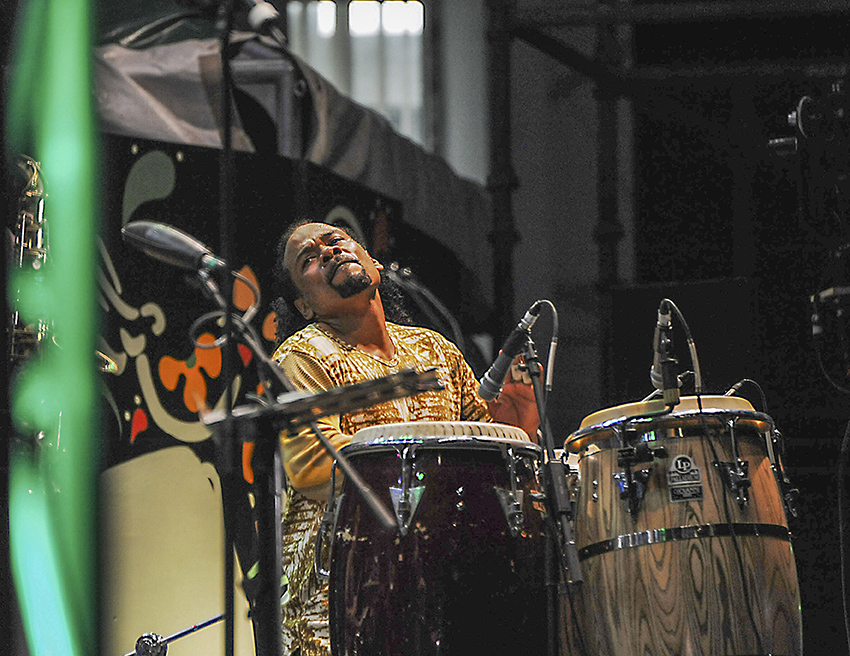
Plaza del Quinto Centenario (Quincentennial Plaza) was inaugurated in 1992 to celebrate the 500th birthday of the founding of the New World by the Spanish.
“It was an instinctive thing. When I heard the drums as a kid, I suddenly felt so connected to that sound. I felt the need to have a drum and play it. I got myself a little conga drum and just imitated the sounds I heard in records. I didn’t even have this dream about being a musician. I just did it because I felt passionate about it and would play all day without stopping until my family begged me to stop at night,” Mejia remembered with a broad smile.
By age 14, Mejias had moved to Toa Baja where he began to play with a Calypso group in the hotels of Dorado, and at 17 he participated in legendary rumba jam sessions in Rio Piedras with conga masters Giovanni Hidalgo and Richie Flores. Mejias jumped to the big stage at age 23 as a bongo and conga player for multi-Grammy laureate, salsa, and Latin jazz bandleader Eddie Palmieri. “There I made a name for myself because I was featured as a conguero doing many solo improvisations. We did France, Germany, UK, Spain, all of Europe and the U.S.,” he said. Reedman Paquito D’Rivera and pianist Chick Correa are among the other jazz greats with whom Mejias has performed.
In 2005 Mejias decided to go his own way and formed the Paoli Mejias Latin Jazz Quintet and released three independent albums. The first one “Mi Tambor” was nominated for a Latin Grammy in the Latin Jazz category competing with legends as Poncho Sanchez and Cuban pianist Bebo Valdes. For several years the quintet played on the international jazz circuit of festivals and clubs.
“I put together my own group because I like to break old patterns and rules and I hate doing the same things, the same way all the time,” said the 47-year-old percussionist. “I tried to incorporate other musical influences into the conga playing, sounds from India, Greece, Africa and Puerto Rico, for example. It used to be that Latin jazz congueros did mostly Afro-Cuban jazz more or less but I wanted to expand that, and I did.”
Then Mejias paused his career as a bandleader to accept an invitation he could not refuse. In 2013, he was recruited as the conguero and multi-ethnic percussionist in the band of legendary Rock guitarist and pioneer of the Latin Rock sound, Carlos Santana. For several years, Santana had used different percussionists and was searching the right person for a steady job, and he found Paoli.
“This is a big organization led by a megastar,” notes Paoli. “And it requires certain energy, a positive attitude on stage, and they found this in me. Carlos says that he sees the light in me, those are his words, not mine,” he laughed. “He told me that he sees in me something he expects of band members: to be someone that adds positively not only in the music but in the good energy, the discipline, the ability to get along with the rest of the band, and the idea is that this energy projects itself on the stage to the audience and everybody can feel it,” Mejias added.
The Santana band is always on tour doing 40 concerts a year in Las Vegas’ Mandalay Bay House of Blues where Santana is a resident artist. Mejias and wife Sarah Vogel recently bought a house in her hometown of Seattle, and they live part of the year there and part in Puerto Rico.
But most of the time Mejias is in Vegas or on the road with Santana and is continuously on the move. This year Mejias played with Santana in Bahrain, United Arab Emirates, as part of the major Grand Prix race, and toured South Africa, with concerts in Johannesburg and Capetown. “In two weeks we’ll be with Santana in Las Vegas where we do four months a year, and we will have two European Tours in the rest of 2018 that include cities in Spain, Italy, France, Finland, and Norway among others,” the master percussionist explained.
“I see this stage with Santana as a parenthesis in my career as a group leader, and at some point, I’ll be back because it’s important for me to be able to display my musical creativity and concepts to the fullest extent,” he said. But no matter how hectic and demanding his calendar with Santana may be, Mejias he has kept producing original music and releasing various single tracks.
“Then I realized I have enough material for a CD so I am working on the final mixing of two of those tracks and it will be ready for release this year,” he said. “My previous albums have been mostly of jazz music, but these have some salsa tracks, and also my original fusions and invented polyrhythm. They all have music and lyrics written and performed by me,” Mejias added.
“Oh, I forgot to tell you, my signature conga with Latin Percussion just came out, it’s called ‘Jazzambia,’ the name of one of my first recordings.” LP signature congas are considered a sort of Hall of Fame distinction for Conga drummers. “What’s so unique is that I was able to design my signature conga, which is not how it usually works, so I’m very happy about it.”
En Mi Viejo San Juan
Anyone who has spent enough time in Old San Juan to be seduced by this gorgeous Spanish colonial jewel by the sea will leave still longing for “en mi Viejo San Juan,” or “in my Old San Juan,” just like that classic romantic ballad by Puerto Rican song writer Noel Estrada says.
Anyone who has spent enough time in Old San Juan to be seduced by this gorgeous Spanish colonial jewel by the sea will leave still longing for “en mi Viejo San Juan,” or “in my Old San Juan,” just like that classic romantic ballad by Puerto Rican song writer Noel Estrada says.
It won’t take long to get smitten. Old San Juan is the Americas’ most stunning restored Spanish colonial sector. Perched on a headland overlooking the dramatic ocean coast and the island’s main harbor, the mile-square city has museums, galleries, and boutiques selling fine art, crafts, and other unique items from around the island, region, and world, as well as some of the city’s finest hotels, restaurants, bars and other night spots.
Its blue-tinged cobblestone streets, originally built from the ballast of New World explorer ships, descend from an ocean-side boulevard to the wide promenade lining the tranquil waters of San Juan bay. They are lined with colorful colonial homes, with balconies full of bougainvillea, and deftly designed office buildings, ancient cathedrals, and stately government buildings and city plazas. The architecture spans Spanish colonial to baroque to Gothic to Art Deco.
At a minimum, you’ll want to spend a morning or afternoon shopping and seeing the sites in Old San Juan, but if time warrants, there is enough to do to fill a full day. Make sure to have a delicious, gorgeously set lunch or dinner (or both!) at one of the Old City’s prime restaurants.
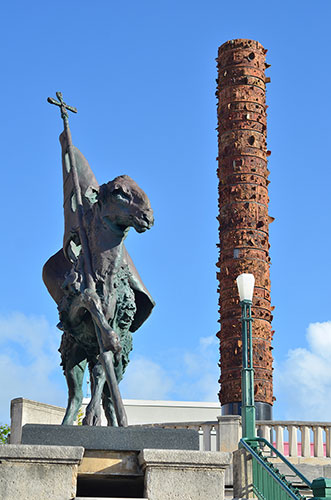
Plaza del Quinto Centenario (Quincentennial Plaza) was inaugurated in 1992 to celebrate the 500th birthday of the founding of the New World by the Spanish.
The Old City is largely defined by its twin fortresses – El Morro, or Castillo de San Felipe del Morro, and San Cristobal, or Castillo San Cristobal – that tower over, respectively, the entrance to San Juan Bay and the narrow land-bridge connecting the old city to the rest of San Juan. They combine to form the San Juan National Historic Site, which is managed by the U.S. National Park Service. There is trolley service between the two installations, but the Oceanside sidewalk makes for a great walk, especially on sunny days.
The fortresses and the massive wall surrounding the city have survived natural disasters and foreign invasions for some five centuries and still wield an enormous presence in the life of Old San Juan. They are filled with historic treasures and offer dramatic views of the tropical ocean, with historic exhibits, guided tours and informational brochures.
El Morro unfolds in a number of layers, with ramps winding from the dungeons to the troop barracks to the iconic guard towers. Its northernmost point overlooks the ocean surf crashing against the rocky coast. The great green lawn surrounding El Morro has become a favorite spot to fly kites and to picnics. Kites and refreshments are available at street carts outside the Spanish colonial fortress.
San Cristobal’s vast walls rise more than 150 feet above the ocean, and various lookouts offer ocean and city views that will only add to you appreciation of Old San Juan’s beauty. The fortress was constructed in circular fashion with the interior area linked by tunnel and moats to its outer rings dedicated to defense. Make sure to check out the killer view from the Devil’s Sentry Box, where Spanish guards were said to disappear without a trace while on watch.
You can ponder in all its glory El Morro, stretching across its vast green grounds and the emerald blue Caribbean horizon, from the nearby Plaza del Quinto Centenario (Quincentennial Plaza). It was inaugurated in 1992 to celebrate the 500th birthday of the founding of the New World by the Spanish, and features a granite and clay totem-like monument and adjacent fountains and sculptures celebrating Puerto Rico’s rich cultural heritage. Beyond the plaza is the Cuartel de Ballaja, a 19th century army barracks that is one of the largest buildings constructed by the Spanish in the Americas. Today it house the Museum of the Americas, focused on indigenous and regional art, a pleasant outdoor cafe and a handsome courtyard that is often host to special events. The Asilo de Beneficencia, a former indigents’ hospital dating from 1832, is also nearby and the Institute of Puerto Rican Culture. Also nearby is Casa Blanca, a charming home that once belonged to Puerto Rico’s first governor, Juan Ponce de Leon, with an interesting museum and gorgeous gardens.
The Old City is host to the Caribbean’s hottest street party, the Fiesta de la Calle San Sebastian in mid-January, but you can catch its spirit on a visit to the street that bears its name on any of San Juan’s sultry nights. San Sebastian is a cobble-stoned street lined with bars and restaurants, and art galleries and workshops are just around its many corners. Laughter and the salsa, bomba and plena music associated with the festival pour out of the bars, with their large wooden doors thrown open to the street. The party has been raging here for more than a century.
This is also the birthplace of “Despacito,” the Luis Fonsi mega-hit featuring Daddy Yankee that has become the most streamed video of all time. The colorful seaside barrio that former Miss Universe 2006 Zuleyka Rivera saunters through in the video is La Perla, which is sandwiched on the Old San Juan coast between the two historic churches. The joyous dance scene at the end takes places at La Factoria, which has been named one of the world’s best bars, on Calle San Sebastian.
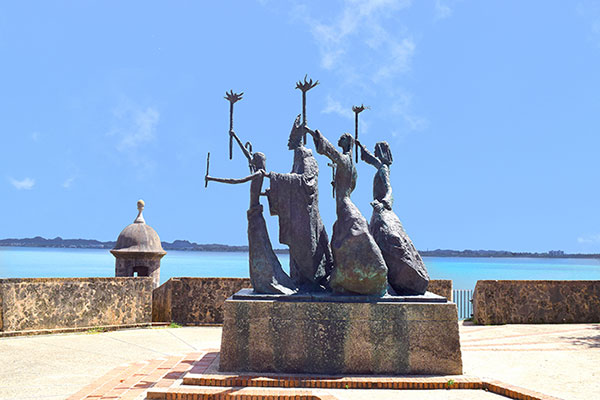
The Plazuela de la Rogativa is a gorgeous shady square overlooking the bay and Puerto Rico’s impressive governor’s mansion, La Fortaleza.
Some of the finest churches in the New World are in the vicinity of Calle San Sebastian and Calle Cristo, including the recently restored San Jose Church, a Gothic rarity and the celestial Catedral de San Juan, a vaulted beauty that is home to the impressive works of religious arts and rare artifacts, as well as the tomb of the island’s first governor, Juan Ponce de Leon, and the mummy of Roman martyr Saint Pio. The Plaza de las Monjas, or Nuns’ Plaza, might be the most deliciously shady spot in all of Puerto Rico, with a bay breeze funneling through tow of the old city’s most gorgeous tree-lined streets, with some of the most gorgeous colonial homes.
If you don’t stay at Hotel El Convento, you’ll want to come by for a tour anyway, if not a meal or a drink at the gorgeous restaurants located in its interior patio and street-level terrace restaurant. It was born in 1651 as a Carmelite convent, and has gone through many lives since then, but today remains a part of the beating heart of the Old San Juan. Its tiled courtyards and terraces are outfitted with gorgeous Spanish furnishings, palm trees, and Caribbean flowering plants, under high-beamed ceilings that are iconic of Old San Juan. It’s really one of the perfect spots to soak up the unique Old San Juan vibe.
In fact the Old City, as it is affectionately known by locals, has wonderful lodging options, including full-scale resort hotels like the Sheraton Old San Juan across from the cruise ship piers. There are also small guest houses and inns with big charm, like Casa Sol Bed and Breakfast, on a beautiful stretch of Calle Sol.
The Plazuela de la Rogativa is a gorgeous shady square overlooking the bay and Puerto Rico’s impressive governor’s mansion, La Fortaleza. Its biggest charm however is a statute of a bishop and three women that recreates a religious procession in 1797 that legend has halted a British attack on San Juan, when sailors mistook the candles of marching nuns for the movement of Spanish reinforcement troops. La Fortaleza, the seat of local government for more than 300 years, is just down the block. The stunner incorporates neoclassical and Arabian elements and has a choice location overlooking San Juan Bay, with great views and breezes in most of the building, and from its many gardens and patios. Tours are available weekdays.
You’ll pass San Juan Gate, which was the main entrance to the city when it was built in 1635, and today leads to the charming stretch of the San Juan bay, with small fishing boats docked just off shore. To the right is a walking path that hugs the base of the massive headland on which El Morro is built and the fortresses ancient walls. The saltwater and sun sprayed path passes dramatic seascapes and patches of sea grapes and tropical vegetation. The mood turns romantic when the El Morro is lit up at night. To the left is Paseo de la Princesa, a bayside promenade between the bay and the massive wall of the ancient city. You’ll see the alluring “Raices” or “Roots,” monument and fountain, which is an impassioned tribute to the Taino, African, and Spanish roots of Puerto Rico and its people, complete with gorgeous gods and goddesses in all their naked glory riding huge sea and land creatures. The beautifully restored La Princesa housing the Puerto Rico Tourism Company Headquarters is also on the promenade, which hosts artisans and sidewalk cafes.
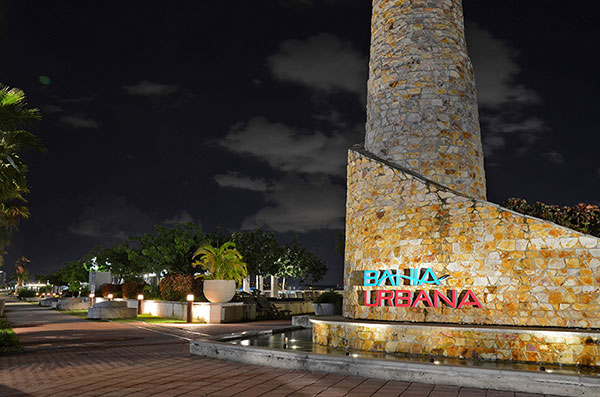
Bahia Urbana, a bayside park on the outskirts of the old city that hosts concerts and special events, as well as ship tours and other tourist adventures.
Cristo and La Fortaleza streets have some of the old city’s smartest boutiques and galleries, but you’ll also want to look to Calle San Francisco, as well as San Jose. There are great cafes, bars, and restaurants throughout the historic sector, but Recinto Sur has become its restaurant row, where you can find classic comida criolla in authentic settings, Spanish food with live flamenco show, inventive contemporary cuisine to live U.S. and Latin Jazz shows and so much more.
Of course one of the joys of the Old City is stumbling around its side streets and cooling off in its gorgeous plazas, which offer shady benches and refreshment stands. Plaza de Colon, at the main entrance to Old San Juan, is centered on a monument of Columbus, but different levels of terraces and fountains and shady corners. Plaza de Las Armas, located at Old San Juan’s heart, is home to the stately San Juan City Hall and Puerto Rico State Department, as well as a number of restaurants and boutiques. The fountain was built to represent the four seasons, and the statue of the gentleman sitting on the bench is Titi Curet, and Old City fixture during his life who was perhaps Puerto Rico’s most prolific writer of salsa music. There are also a number of plazas near the cruise ship ports along the bay.
Artisans often hawk their wares in the plazas and promenades while musicians perform in these public spaces as well. In fact, the city of San Juan has a continuing live music program throughout Old San Juan and the rest of the city that take place on certain nights and weekends throughout the year. The newest addition to the ports area is Bahia Urbana, a bayside park on the outskirts of the old city that hosts concerts and special events, as well as ship tours and other tourist adventures.
Old San Juan is only one-square mile, but it can take days to explore its many charms. When it comes time to say goodbye, you’ll already be plotting a return to, as the Estrada song says, “search for my love, and dream again, in my Old San Juan.”
Hot spots right now
In San Juan, one of the most cosmopolitan cities in the Caribbean, trendy and new restaurants are on nearly every corner. There’s no denying the appeal of hitting up the trendiest spots in town to get those hearts pumping and taste buds delighted.
In San Juan, one of the most cosmopolitan cities in the Caribbean, trendy and new restaurants are on nearly every corner.
There’s no denying the appeal of hitting up the trendiest spots in town to get those hearts pumping and taste buds delighted.
Cocina Abierta in Condado is an interactive open kitchen where culinary ideas are inspired and created. Just like the restaurant’s name suggests, the chef opens his kitchen to share best-kept secrets and knowledge inside this unique Atelier kitchen.
The contemporary and eclectic décor is a mélange of concrete walls, modern light fixtures, custom-made furniture, and repurposed decorative pieces; making it one of the most creative multi-layered spaces in Puerto Rico.
The menu is divided into five acts, allowing you to mix, match and create your ultimate tasting menu. Three wine pairing suggestions accompany each dish.
Don’t skip on the cocktails! They are hand-crafted at the Tiki Bar by expert mixologists who use local ingredients and top-shelf liquors from the world-class collection.
VIVO Beach Club is Puerto Rico’s liveliest oceanfront destination featuring an outdoor beach club and pool, restaurants and bars, and a full-scale brewery called Ocean Lab. It serves comfort food in a casual environment with 9 plasmas to watch sports or just relax and taste the diverse offering of local beers. Guests can experience how beer is produced by taking a tour in the microbrewery.
Situated on one of the island’s top ranked beaches and next to the Isla Verde’s hotel district, VIVO Beach Club has the perfect ingredients for a great Caribbean experience. This hip venue has established itself as the best day and night club in the metropolitan area.
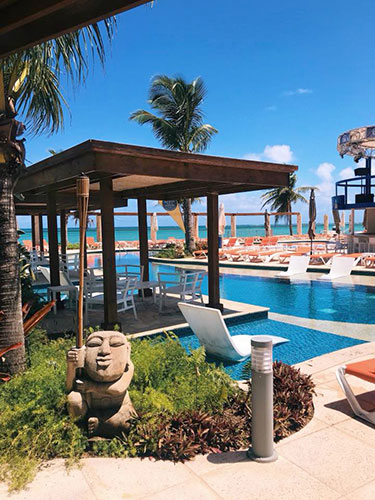
VIVO Beach Club is Puerto Rico’s liveliest oceanfront destination featuring an outdoor beach club and pool, restaurants and bars, and a full-scale brewery called Ocean Lab.
VIVO’s AT&T Arena includes a 9,000 square foot stage that can easily cater to over 30 musicians for a large array of performances, as well as a dance floor and multiple staging areas to accommodate over 5,000 people.
La Placita, the last of the traditional fresh food markets in Puerto Rico before the arrival of supermarkets in the 1970s, is still the heart and soul of Santurce’s hottest nightlife scene.
You can still buy fruits, vegetables, flowers, street food, and fruit shakes during the day. But La Placita is now known for its dozens of restaurants with extensive menu selections, cafes, and nightclubs that surround the traditional food market building.
Especially good on Thursday and Friday nights, the historic market plaza and its surrounding streets host what becomes a street party with people of all ages crowding the square to mingle, talk, drink, listen, and dance to music until the wee hours. The vibe is fun and laid back.
Move over old-school steakhouses, Rare 125º Neighborhood Grill in Miramar has arrived with a modern approach, excellent cuts, sides, and sauces. The restaurant is upscale and trendy without the pretensions of white tablecloths, providing top-notch service.
The lunch options are enticing, with bento box–style steak lunches.
Rare 125° refers to the ideal preparation of the perfect steak, and while this is not a house rule overriding your preferences, it is a commitment to providing the ultimate restaurant experience.
House specialty appetizers are the Beef Tataki and Pork Belly Chicharron. The pork belly is a crowd pleaser of crispy comfort served with whipped black refried beans and a cleansing lemon crème. The Tataki consists of a few slices of the house specialty pastrami rubbed steak, a small mound of dulcet mushroom escabeche, ponzu sauce, and thinly sliced cucumber.
Rare 125° opens for lunch every day from 11:30 a.m. to 3 p.m. and features wraps, burgers, and $15 lunch boxes like the pork tenderloin with vegetable risotto and guava marmalade.
Puerto Rican artisan wholesale bakery Cidrines opened a stylish venue, SOBAO by Los Cidrines, located at the AC Hotel by Marriott in Condado. The name SOBAO originates from Sobao sweet bread, the company’s star product responsible for its success.
Along with the bakery, the venue also includes a restaurant called La Bodeguita, which offers a genuinely spectacular culinary experience.
Upon entering the restaurant, you will see a display of photos and tasteful memorabilia honoring the life of Doña Lidia Miranda and her family, the Cidrines.
The menu at La Bodeguita has a good selection of wines and fresh fish, meat, chicken and pasta and its famous Cocas (similar to pizzas), burgers and tapas. Sobao by Los Cidrines has live music every Thursday, Friday, and Saturday evening.
El Mercado de Paseo Caribe is a modern, upscale food market inside a luxurious waterfront residential complex that brings together a mix of local gourmet restaurants, butcher shops, and other gourmet food boutiques under one roof.
The market has a vibrant feel with its restaurant kitchens and food vendors complimented by the vast, colorful mural created by renowned artist Tom Christopher.
Eateries like Café Alto Grande, Napolitana pizzeria, and the Noodle Merchant rub elbows with well-known local favorites like La Hacienda Meat Market from Miramar, Señor Paleta from Old San Juan, and El Pescador from Santurce, just to name a few.
Along with the impressive array of food options, El Mercado de Paseo Caribe also hosts live entertainment.
Princesa Gastrobar, nestled in a beautiful garden patio surrounded by lush vegetation and trees next to the old La Princesa jail which today houses the offices of the Puerto Rico Tourism Co., sits at the edge of the famous city wall that historically encompassed all of Old City.
The restaurant’s menu features some unique recipes found in an 1800’s Puerto Rican cookbook that blends Spanish and Puerto Rican dishes. These recipes are marked on the menu by a local tree frog called the Coqui.
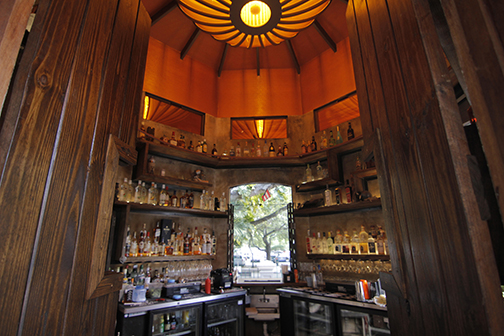
Princesa Gastrobar is nestled in a beautiful garden patio surrounded by lush vegetation and trees next to the old La Princesa jail.
Its specialty is Spanish croquettes, heavenly bites made with chicken and Iberian ham and served over béchamel sauce. Princesa Gastrobar also offers a variety of refreshing rum cocktails and educates its visitors about the history of the Rums of Puerto Rico.
This exclusive venue will make its visitors feel the magic of the story behind its unique location.
Casa Cortes ChocoBar is a restaurant and art gallery in Old San Juan operated by the Cortes family, the biggest chocolate-makers in the entire Caribbean.
They opened this popular and unique venue, voted Best Restaurant in the Caribbean by the readers of USA Today, to share tasty meals and drinks that incorporate the family’s greatest treasure — wickedly delicious chocolate.
The chocolate drinks are out of this world. Get them hot or cold, or with marshmallows. The menu includes specialty drinks like a Choco Martini or Bloody Choco Mary. There are breakfast items, appetizers, sandwiches, entrees, and pastries where chocolate infuses every bite.
On Thursday, Saturday, and Sunday a gallery upstairs offers a glimpse of the family’s private contemporary Caribbean art collection.
Looking for a stiff drink? Then La Casita de Rones in Old San Juan is the right place. This pink-colored lovely venue (once the home of the Puerto Rico Tourism Company Information Center) has two bars, a restaurant, and shop developed by the local government to promote the Rums of Puerto Rico program.
This charming venue in the touristic area of the Old City next to the cruise ship terminals and with views of the San Juan Bay sells and promotes brands like Bacardi, Serralles, Club Caribe, Barrilito, Caray and Trigo and artisanal products by Destileria Cruz, and El Pitorro de Destileria Coqui.
A variety of mouthwatering rum-based signature concoctions, handcrafted and pressed sangrias, and tropical classics, like the famous piña colada, are masterly crafted here to compliment a varied selection of Puerto Rican appetizers, salads, sharing dishes, and entrees.
So check them out. You might just spot some celebrities while you’re there!
Mysterious San Juan
The ancient city tells its own hidden history
The city of San Juan was founded in 1520 after Juan Ponce de Leon decided to relocate from the town of Caparra.
Extreme heat and humidity as well as rebellious Taino Indians made them resettle on the edge of a 2.5 mile size isle overlooking the bay where they had already established a port.
The first dwellers were mostly gold diggers and a number of clergymen. This first settlement to San Juan occurred 100 years before the Mayflower pilgrims arrived at Plymouth.
San Juan developed into a full blown city by the late 18th century and its growth was limited because it was confined within walls built to protect it from invaders
During the 19th century, San Juan was overcrowded and a busy center of commerce, government, military, and cultural life. After the settlement of Americans and the tearing down of inland walls, wealthy and upper middle class families started moving to areas like Condado and Miramar, and the Old City became an impoverished working class town.
A restoration project in the 1970’s and a growing conscience of the city’s charm started attracting middle-class and affluent families. The one constant trait of today’s sanjuaneros is that they are proud of their town and prefer to live in a cultural and historic ambiance rather than in the midst of suburban life full of asphalt and shopping malls.
The walking tour
Bienvenidos participated in a walking tour called San Juan Oculto (Hidden San Juan), a project designed to reveal the architectural wonders and details of the Old City. It was initiated by a group of volunteers, graduate students and teachers from the University of Puerto Rico’s School of Architecture, who teamed up with the San Martin de Porres Foundation. The idea was to develop an educational walking tour as a source of funding- the cost of the tour is what the guest wishes to donate towards the foundation’s work in needy areas of Haiti and the Dominican Republic.
“We want to include tourists, visitors, and student groups who want to learn about the richness, and history present when you walk through Old San Juan,” said Prof. Jorge Lizardi-Pollock, who leads the project along with Pedro Van Marissing of the Foundation.
San Juan Oculto offers three different routes. The first called One City, Many Pasts demonstrates the different historical layers preserved in architectural styles. The second called Architecture, Order and Authority in the Old City explores the structures related to the institutions of power in Spanish colonial times and the third route called San Juan, A Swarm or Everyday Practices focuses on the city as it worked for the common person before electricity and modern aqueducts.
Here come the cabezudos
The century’s old tradition of full head puppets is alive and right in the heart of Puerto Rico’s largest street festival in Old San Juan
“Hurry up, the cabezudos parade is going to start!”
People are scrambling for a great spot to see the action, dads are carrying small children over their arms, and everyone has their phones out ready to take pictures or record. Nobody wants to miss the action.
The narrow street in Old San Juan is packed because the cabezudos, known as bigheads or full head puppets, are about to begin the colorful march that kicks off the traditional Fiestas of San Sebastian Street (the Fiestas), held every year on the third weekend of January. It’s a huge popular celebration that has become the largest festival in all of the Caribbean, equivalent to the island’s very own Mardi Gras.
The crowd jams out to the middle of the street and once the loud countdown reaches zero the city mayor cuts the ribbon of official ceremony, cheers erupt and the Fiestas have begun.
Then the cabezudos begin their march down the street to the beat of traditional plena drums and chants and a feisty marching brass band is immediately joined by hundreds of spectators old and young, who instantly turn from audience to participants in the swinging and joyful trek. Some of the first cabezudos that appear depict historical or folk characters of the Old City, like Doña Fela, the famous mayor of the 40’s and 50’s known for her towering Marge Simpson- style hairdo or Diplo, a popular comedy character from the same era.
Children giggle and point at the cabezudos or try to touch them while others just stare in awe. “The cabezudos parade is one of those things that make me feel like a little boy again,” said a smiling David Padilla, who is a 55 year-old resident of San Juan who never misses the event.
Next come the comparsa or marching crew of the Agua Sol y Sereno theater company, with an explosion of energy and circus-like ambiance. More than 40 finely crafted cabezudos and giant puppets among a colorfully clad of stilt walkers manage to dance to the tropical rhythm of plena.
“I remember as a kid I was so excited to be in the cabezudos parade!” said Maria Muñoz, a 20 year-old college student from the west coast of Puerto Rico. It also made me so curious that I would bombard my parents with questions about who those characters were and their history. It’s a very exciting event and when I have kids I will definitely bring them to the parade and the Fiestas.”
Medieval roots
The tradition of the cabezudos began in Spain around the 12th century specifically in festivities in northern Basque Country, and in the provinces (then kingdoms) of Aragon and Valencia, among others. According to Spanish historian Javier Aparicio, the tradition became widespread as the catholic kings conquered Spain again from Islamic rule in the late 15th century. The reason, according to Aparicio, was that Islamic law prohibited depictions of saints and even ordinary people so when the Catholics regained power these restrictions were eliminated and the use of cabezudos and giant puppets proliferated through most regions.
In Puerto Rico it all started in the mid 1950’s when the parish priest in Old San Juan’s Church of San Jose organized a religious procession mixed with music and festivities to honor Saint Sebastian, the patron of the street where the temple was built and situated in 1511.
The priest, Juan Manuel Madrazo, a native of the northern Basque Country of Spain, started the festivity to help finance the repairs of the San Jose church, the second oldest Christian temple in the Americas, as well as a school he was starting in Barrio La Perla, which lies just outside the ancient city walls.
Father Madrazo went to Spain for vacation and came back with two giant puppets, known also as gigantones and a couple of cabezudos. The Basque Country of Spain is one of the regions where this tradition has been in place for centuries.
The cabezudos brought by father Madrazo were called sanchos, after the famous literary character of Don Quijote’s partner and a symbol of the ordinary man of the village. The two giant puppets depicted the 16th century Catholic kings of Spain, Fernando and Isabel, precisely the ones who conquered Spain for the second time from the Islamic rulers and sent Christopher Columbus off to conquer the New World.
So these colorful puppets of enormous heads designed to stand out in a crowd became the heart and soul of the Fiestas, kicking off the festivities with a parade along the street that featured the cabezudos along with marching bands. The event was celebrated during the 1950’s and it was a great neighborhood block party for residents of Old San Juan but unknown to the rest of Puerto Rico. Read more
Art styles from realism to abstract painting
Puerto Rico is an island where its creative talent and plastic arts overflow, and painting is no exception. The work of dozens of Puerto Rican artists can be appreciated at key museums and galleries in Puerto Rico, the U.S. mainland, Latin America, and Europe.
Four local stars share their style, techniques and vision
Puerto Rico is an island where its creative talent and plastic arts overflow, and painting is no exception. The work of dozens of Puerto Rican artists can be appreciated at key museums and galleries in Puerto Rico, the U.S. mainland, Latin America, and Europe.
From Jose Campeche – the forefather of Puerto Rican artists to the contemporaries; local artists have cultivated a great variety of styles that go from realism to figurative to abstract.
BIENVENIDOS interviewed four Puerto Rican internationally renowned artists who reflect some of the aforementioned tendencies and exemplify the quality of art developed on the island.

